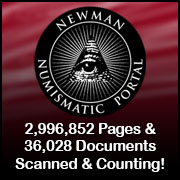
About UsThe Numismatic Bibliomania Society is a non-profit association devoted to the study and enjoyment of numismatic literature. For more information please see our web site at coinbooks.org SubscriptionsThose wishing to become new E-Sylum subscribers (or wishing to Unsubscribe) can go to the following web page link MembershipThere is a membership application available on the web site Membership Application To join, print the application and return it with your check to the address printed on the application. Print/Digital membership is $40 to addresses in the U.S., and $60 elsewhere. A digital-only membership is available for $25. For those without web access, write to: Charles Heck, Treasurer
AsylumFor Asylum mailing address changes and other membership questions, contact Chuck at this email address: treasurer@coinbooks.org SubmissionsTo submit items for publication in The E-Sylum, write to the Editor at this address: whomren@gmail.com BUY THE BOOK BEFORE THE COINSale Calendar |
- WAYNE'S WORDS: THE E-SYLUM FEBRUARY 26, 2020
- ASYLUM SPRING 2020 ISSUE PUBLISHED
- KOLBE & FANNING OFFER NEW NUMISMATIC TITLES
- BANKNOTE BOOK USSR CHAPTER PUBLISHED
- NEW BOOK: IN THE WAVES
- HISTORICAL MEDAL JOURNAL LAUNCHED
- ATLANTA BOOK SIGNING: IN GOD WE TRUST
- SHANNA SCHMIDT ON NUMISMATIC LIBRARIES
- ROBERT MARTIN CONNECTICUT COPPER NOTEBOOKS
- U.S. CONGRESSIONAL REPORTS ON NEWMAN PORTAL
- THE HOWARD D. GIBBS ARCHIVES
- VIDEO: NSDR PRESIDENT JEFF WULLER
- QUERY: CENTRAL AMERICAN FEDERATION COUNTERSTAMP
- MORE ON THE FUGIO CENTS IN LUCITE
- NOTES FROM E-SYLUM READERS: FEBRUARY 23, 2020
- SEARCHING FOR ONE MERCURY DIME TYPE COIN
- VOCABULARY TERM: IMPRESSED DESIGN
- KUNZE, REV. JOHANN CHRISTOPH (1744-1807)
- STACK'S BOWERS ON THE MOVE IN NEW YORK
- 2020 HONG KONG SHOW AND SALE POSTPONED
- ANCIENT GEMS AND THEIR CONNECTION TO COINS
- 2020 BRITISH HISTORICAL MEDALLION CONGRESS
- THE DUBAI COINS MUSEUM
- WAYNE'S NUMISMATIC DIARY: FEBRUARY 23, 2020
- COINAGE OF THE SIERRA LEONE COMPANY
- 1913 SANDBLAST PROOF DOUBLE EAGLE
- PERATROVICH DOLLAR MAY CIRCULATE IN ALASKA
- AUSTRALIA'S QANTAS AIRLINE COMMEMORATIVE COINS
- THE ADAMS COMITIA AMERICANA MEDAL COLLECTION
- THE SELLING OF THE BAKER COLLECTION
- THE RISE AND FALL OF ARISTOPHIL
- LOOSE CHANGE: FEBRUARY 23, 2020
Click here to access the complete archive
To comment or submit articles, reply to whomren@gmail.com
Content presented in The E-Sylum is not necessarily researched or independently fact-checked, and views expressed do not necessarily represent those of the Numismatic Bibliomania Society.
WAYNE'S WORDS: THE E-SYLUM FEBRUARY 26, 2020
 This week we open with a new issue of The Asylum, new publication offerings from Kolbe & Fanning, two new books, a new journal, and more.
This week we open with a new issue of The Asylum, new publication offerings from Kolbe & Fanning, two new books, a new journal, and more.
Other topics this week include updates from the Newman Numismatic Portal, primitive money collector Howard Gibbs, Fugio cents in Lucite, impressed designs, ancient engraved gems, the Dubai coins museum, the 1913 sandblast proof double eagle, and the John W, Adams collection of Comitia Americana medals.
To learn more about coins of the fisherman, George Dixon's lucky gold coin, the Historical Medal Journal, Connecticut Coppers, the Quetzal bird over volcano and radiant sun countermark, Stack's Bowers' new location in NYC, and French Provincial Belle Epoche medals, read on. Have a great week, everyone!
Wayne Homren
Editor, The E-Sylum
ASYLUM SPRING 2020 ISSUE PUBLISHED
Editor Maria Fanning reports that the latest issue of our print journal The Asylum is on the way to the mailboxes of Numismatic Bibliomania Society members. Here is the table of contents and a message from our President Tom Harrison, and a call for input for the next issue. -Editor
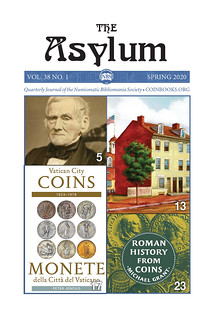 The Asylum
The Asylum
Spring 2020
Volume 38 Number 1
Table of Contents
- ASSOCIATIONS: Autographs • Annotations • Inscriptions: Samuel Breck on… Massachusetts Coinage?" By Joel J. Orosz
- "A Chance Encounter" By Pete Smith
- "The Coins of the Fisherman: Two Books on Papal and Vatican Numismatics Including a Review of Vatican City Coins 1929–1978 by Peter Jencius" By William Van Ornum
- "That Other Book Club" By Pete Smith
- "Throwing Light on the Past: Roman History from Coins by Michael Grant" By David Pickup
Message from President Tom Harrison
Numismatists, by nature, are a generous fraternity with NBS members, past and present, among the foremost in the hobby. For example, in 1988 at the NBS Board Meeting in Cincinnati, the treasurer reported the coffers were nearly exhausted. So at the General Meeting, a plastic bag, “the hat,” was passed resulting in a $1607 boost to the treasury. In the past, the NBS has made financial contributions to the ANA and ANS libraries. Many members have generously donated items for the benefit auction and openhandedly purchased lots to support the NBS.
Historically, in addition to financial support, the NBS has been fortunate to have members step forward to serve on the Board, as Treasurer, The Asylum Editor and The E-Sylum Editor. Friends of the NBS have provided engaging articles for The Asylum, spoken at our educational forums, hosted the club table, served as auctioneer, and the list goes on and on.
In the most recent example of generosity, several anonymous members donated the extensive George F. Kolbe archives sold in the Kolbe & Fanning sale of George's library, to the ANS library on behalf of the NBS. This treasure trove of correspondence, photographs and ephemeral items that focus on prominent literature personalities and events, is now available for current and future numismatists to explore and enjoy. Additionally, NBS members donated two other significant lots from the sale. NBS Vice President Len Augsburger donated several limited edition volumes by Remy Bourne detailing United States fixed price and premium lists. Also, NBS past President and current board member Dan Hamelberg donated George Kolbe's complete set of his own special hardcover auction catalogs. In a fitting tribute, NBS board members Dave Steine and Dan Hamelberg presented George with his unique large paper copy of The Reference Library of a Numismatic Bookseller at the New York International Numismatic Convention.
These thoughtful gestures continue to demonstrate the willingness of NBS members to share their passion for numismatic literature with the greater collecting community. The NBS is truly grateful for this enduring tradition of generosity of time, talent and resources that sustains and defines our amazing organization.
I hope everyone enjoyed listening to the first NBS podcast, “NBS Bibliotalk: The Coin Book Lover Podcast,” produced by Lianna Spurrier, that featured an entertaining and informative interview with NBS Historian Joel Orosz. We are delighted to report that Dennis Tucker, award-winning numismatic researcher and author and publisher at Whitman Publishing, will be featured in our upcoming podcast. Please watch for an announcement of the podcast's release in The E-Sylum.
May your numismatic library provide investigation, discovery, and most of all, enjoyment.
From The Asylum Editor Maria Fanning
"Evolution of a Numismatic Library”
Thank you, NBS members, for another great year of The Asylum. Your contributions made our 40th Anniversary issue one of the best yet!
The theme of the next issue will be “Evolution of a Numismatic Library.” Dan Hamelberg so generously shared his library with NBS members last August (“Invasion of Champaign,” The Asylum vol. 37, no. 3) and we want to learn about yours.
We want to read about how your library has grown and changed over the years. Have you built an addition to your home, rented a storage unit or filled your spouse's china cabinet to hold your expanding collection? Has the focus of your collecting changed over time or have your studies piqued your interest in completely different areas? We would love to read about how your library is arranged and decorated with unusual numismatic art and ephemeral items, too. As always, please share lots of photos of your inner sanctum and treasures.
Please send submissions to asylum@coinbooks.org by May 1 to be included. Thank you in advance for your contributions!
Remember, while The E-Sylum is free to all, only paid members of the Numismatic Bibliomania Society receive our print journal, The Asylum. Print/Digital membership is $40 to addresses in the U.S., and $60 elsewhere. A digital-only membership is available for $25. -Editor
To join NBS or renew your membership, see:
https://www.coinbooks.org/about/membership.html
KOLBE & FANNING OFFER NEW NUMISMATIC TITLES
Numismatic booksellers Kolbe & Fanning are offering a number of new publications. -Editor
New Numismatic Publications Available from Kolbe & Fanning
Kolbe & Fanning have added more newly published titles to our online bookstore at numislit.com. Browse our stock for these titles and many more:
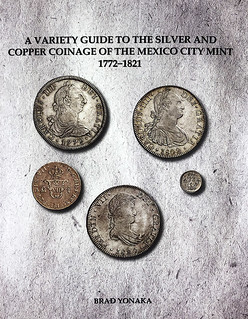
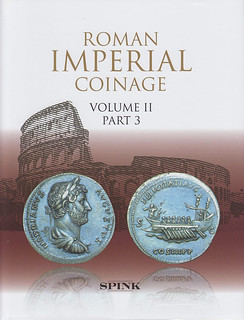
A VARIETY GUIDE TO THE SILVER AND COPPER COINAGE OF THE MEXICO CITY MINT 1772–1821, by Brad Yonaka
THE ROMAN IMPERIAL COINAGE. VOLUME II—PART 3, FROM AD 117–138 HADRIAN, by R.A. Abdy and P.F. Mittag.
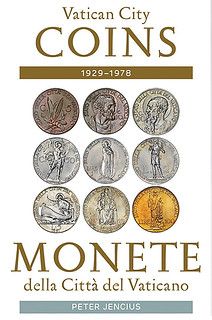
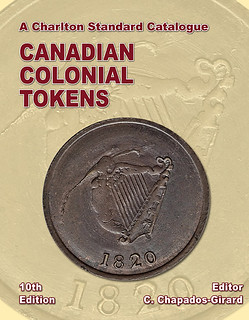
VATICAN CITY COINS: 1929–1978, by Peter Jencius
CANADIAN COLONIAL TOKENS: A CHARLTON STANDARD CATALOGUE, edited by C. Chapados-Girard
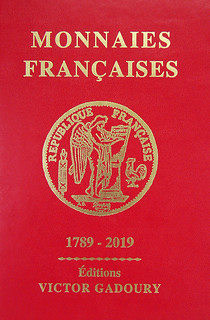
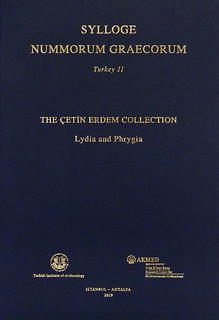
MONNAIES FRANÇAISES 1789–2019, by Victor Gadoury
SYLLOGE NUMMORUM GRAECORUM. TURKEY 11: THE ÇETIN ERDEM COLLECTION. LYDIAN AND PHRYGIA.
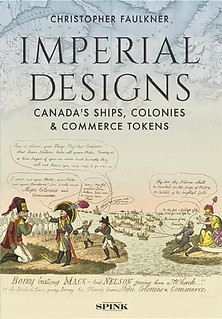
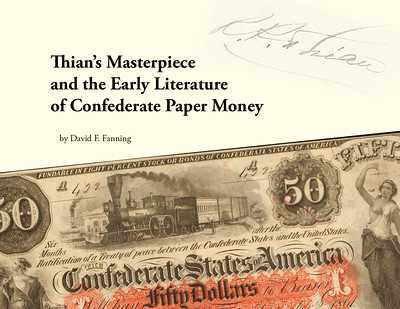
IMPERIAL DESIGNS: CANADA'S SHIPS, COLONIES & COMMERCE TOKENS, by Christopher Faulkner
THIAN'S MASTERPIECE AND THE EARLY LITERATURE OF CONFEDERATE PAPER MONEY, by David F. Fanning
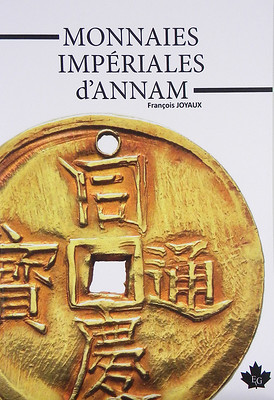
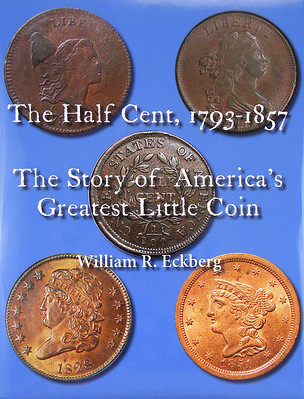
MONNAIES IMPÉRIALES D'ANNAM, by François Joyaux
THE HALF CENT, 1793–1857: THE STORY OF AMERICA'S GREATEST LITTLE COIN, by William R. Eckberg
Over 1000 titles are currently available for immediate purchase on the Kolbe & Fanning website, including both new and secondhand copies of books and catalogues in all areas of numismatics. See what we have to offer at numislit.com!
BANKNOTE BOOK USSR CHAPTER PUBLISHED
Owen Linzmayer publishes The Banknote Book, a useful, constantly updated electronic reference. On February 21, 2020 he announced via email the availability of the chapter on the banknotes of the U.S.S.R. It's available for $9.99. -Editor
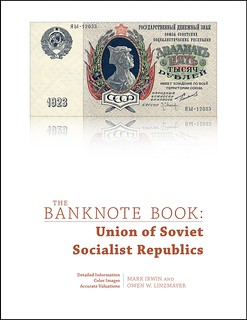 Prolific contributor Mark Irwin has produced another monstrously large masterpiece with this week's publication of the USSR chapter.
Prolific contributor Mark Irwin has produced another monstrously large masterpiece with this week's publication of the USSR chapter.
Union of Soviet Socialist Republics (Europe)
This 40-page catalog covers notes issued by the State Treasury, State Bank, Greater Japan Imperial Government, Emission Bank, Institute of External Funding, and Central Bank of Ukraine. Published
17.02.2020.
For more information on The Banknote Book, see:
http://www.banknotenews.com/banknote_book/banknote_book.php
NEW BOOK: IN THE WAVES
Thanks to Dick Hanscom for passing along this Daily Mail article mentioning a new book on the Confederate submarine H. L. Hunley. The numismatic connection is the famous engraved life-saving double eagle carried by one of its doomed occupants. -Editor
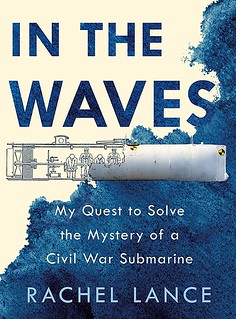 The scientist who cracked the 150-year-old mystery of the
the sinking of the H.L. Hunley Confederate submarine has revealed the painstaking steps she took to demonstrate what killed its eight-man crew.
The scientist who cracked the 150-year-old mystery of the
the sinking of the H.L. Hunley Confederate submarine has revealed the painstaking steps she took to demonstrate what killed its eight-man crew.
Rachel Lance, a biomedical engineer and blast-injury specialist, describes her breakthrough in the forthcoming book In the Waves: My Quest to Solve The Mystery of A Civil War Submarine, due out April 7.
The Hunley was the first combat submarine to sink an enemy warship, but as soon as it succeeded in its mission targeting the USS Housatonic in Charleston harbor in 1864, it mysteriously sank with all hands lost.
The sub was raised from the ocean floor in 2000, adding to the mystery when it became clear that there was no damage to the hull itself.
While many theories have been put forward, Lance believes that the crew was killed nearly instantly by the pressure wave from their own torpedo.
She constructed a precise computer model of the ship to determine its volume, and calculated that the crew would have had a 30- to 60-minute window of warning from the time the first effects of oxygen deprivation became noticeable.
Next, Lance constructed a 1/6 scale model of the Hunely and its torpedo.
Unlike modern, self-propelled torpedoes, the Hunley's torpedo was a copper keg filled with black powder and attached to a 16-foot spar on the bow of the submarine,
The sub had to maneuver the torpedo against the hull of an enemy ship and detonate it while still attached to the spar.
Lance had to secure permission from the Bureau of Alcohol, Tobacco and Firearms to legally purchase the amount of black powder she needed for the experiment.
She also had to find a willing farmer with a pond she could use for underwater testing, since officials at Duke balked at her proposal to set off explosive charges in the retention pond on campus.
The experiment nearly ended in disaster when Lance and her boyfriend were driving with 20 pounds of black powder in the trunk of her car, after a serious crash on the highway right in front of them.
Lance slammed on the brakes and narrowly avoided being rear-ended by the truck behind her, a collision that would have likely triggered a deadly explosion.
Finally, Lance was ready to carry out the experiments on her scale model of the sub, which she dubbed the CSS Tiny.
'We set off as many charges as we could before the sun began to set on the pond. Blast after blast, we captured and saved the waveforms. I was thrilled to see that the readings looked consistent,' Lance wrote.
'And like the actual Hunley, the scale-model Tiny refused to show any damage itself, even after repeated blasts, even as it transmitted the pressures inside.'
The data showed that the blast wave from the explosion passed through the ship's hull and then bounced around on the inside of the cramped submarine, with enough force to be lethal.
'My analysis showed that the amount of pressure ricocheting around inside the metal tube, combined with the quick rise time of the wave, would have put each member of the Hunley's crew at a 95 percent risk of immediate, severe pulmonary trauma,' Lance wrote.
Lance believes that death would have been nearly instantaneous for the crew of the Hunley.
To read the complete article, see:
How eight crew members on board the Confederate H.L. Hunley submarine were killed by
their OWN torpedo after they sank a Union warship in 1864 (https://www.dailymail.co.uk/news/article-8021941/Rachel-Lance-reveals-solved-mystery-H-L-Hunley.html)
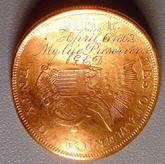 Lt. George Dixon, the sub's
commander, carried with him a special $20 gold piece. "Early in the war, in Mobile, Ala., Queenie Bennett (Dixon's fiancee) gave him a $20 gold piece. While at Shiloh, a Union bullet
penetrated his trouser pocket and struck the coin. The impact left the gold piece shaped like a bell, with the bullet embedded in it. If it wasn't for that coin, he probably would have died on
the battlefield and the Hunley might never have made history. He would carry that coin the rest of his life..."
Lt. George Dixon, the sub's
commander, carried with him a special $20 gold piece. "Early in the war, in Mobile, Ala., Queenie Bennett (Dixon's fiancee) gave him a $20 gold piece. While at Shiloh, a Union bullet
penetrated his trouser pocket and struck the coin. The impact left the gold piece shaped like a bell, with the bullet embedded in it. If it wasn't for that coin, he probably would have died on
the battlefield and the Hunley might never have made history. He would carry that coin the rest of his life..."
To read earlier E-Sylum articles, see:
HUNLEY SUB LUCKY GOLD COIN FOUND (https://www.coinbooks.org/esylum_v04n22a05.html)
UPDATE ON THE HUNLEY, THE LUCKY COIN SUBMARINE (https://www.coinbooks.org/esylum_v13n32a16.html)
HOW LUCKY COIN SUBMARINE HUNLEY WORKED (https://www.coinbooks.org/v20/esylum_v20n24a15.html)
HISTORICAL MEDAL JOURNAL LAUNCHED
Andrew Wager is Chairman of the British Historical Medallion Society which organizes a Congress every year in Warwick, UK. The society recently started new annual publication. -Editor
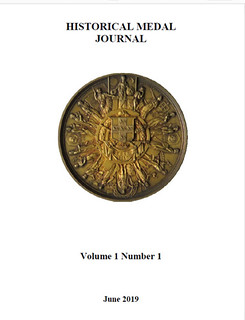
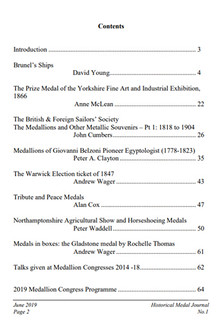
To coincide with the annual Historical Medallion society's annual conference held in Warwick in June the first volume of a new annual Historical medallion journal has been published. Entitled the
Historical Medal Journal (HMJ for short); it was all delegates and is also available on subscription. UK collectors can have a copy of this journal for £8 including postage. (USA and Europe
£12) Published in a similar format to the Token Corresponding Society Bulletin, the journal is 64 pages long, with full colour illustrations and contains articles on a wide variety of topics to do
with historical medals. Submissions of articles for next year's journal are already invited. Collectors or institutions interested in having a copy or submitting an article should contact the
publishers on this email:
medallioncongress14@gmail.com
The 2020 Historical Medallion Congress will be held at the Hilton Hotel in Warwick on Saturday 13 June. As usual the Congress will include a range of talks from well-known speakers, a bourse and
an opportunity to meet fellow collectors in a friendly setting. For further details contact the organisers Andrew Wager and John Cumbers at
medallioncongress14@gmail.com
Andrew adds:
"We are also looking to publish articles on medals and would invite anyone interested to submit them for the 2020 volume, which is published in June, or subsequent issues."

ATLANTA BOOK SIGNING: IN GOD WE TRUST
Bill Bierly, author of the great new Whitman book In God We Trust will be available to sign copies at the ANA National Money Show this week in Atlanta. Stop by if you're at the show! -Editor
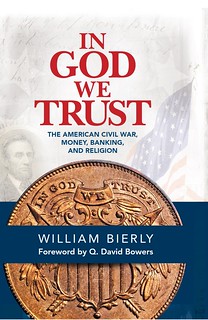 Whitman Publishing author William Bierly will meet collectors
and autograph copies of his new book, In God We Trust: The American Civil War, Money, Banking, and Religion, at the American Numismatic Association's National Money Show, February 27 and 28,
2020, in Atlanta, Georgia. The 352-page hardcover book will be available at the show at the Stanton Books and Stone Mountain Supply booth.
Whitman Publishing author William Bierly will meet collectors
and autograph copies of his new book, In God We Trust: The American Civil War, Money, Banking, and Religion, at the American Numismatic Association's National Money Show, February 27 and 28,
2020, in Atlanta, Georgia. The 352-page hardcover book will be available at the show at the Stanton Books and Stone Mountain Supply booth.
Bierly will be at the Stanton Books booth on Thursday and Friday, with times to be announced at the show.
The national motto “In God We Trust” debuted on United States coinage during the American Civil War. It has appeared on our money ever since. Bierly, having researched deep into the origins and history of “In God We Trust,” tells its full story for the first time, introducing Reverend Mark Watkinson, the preacher who inspired the Treasury Department to “recognize Almighty God in some form on our coins” . . . Mint Director James Pollock, former governor of Pennsylvania, “a commanding figure” who worked toward the same vision . . . and Treasury Secretary Salmon P. Chase, nephew of an Episcopal bishop, who marshalled the nation's resources and financed the war with bold innovations. President Abraham Lincoln figures in the tale, as does a cast of military generals, wealthy industrialists, poets and artists, powerful bankers, and everyday Americans, North and South.
Bierly shows how the upheaval of the Civil War changed not just the face of our coins and paper currency, but the very foundations of modern American banking and finance.
The story continues into the renaissance of beautiful American coinage started by President Theodore Roosevelt in the early 1900s . . . the religious revival of the 1950s, and the “Unwritten Constitution” . . . legal challenges by modern-day atheists . . . and controversy surrounding “In God We Trust,” public and school prayer, Ceremonial Deism, the separation of Church and State, and other topics very relevant in today's social and political conversations.
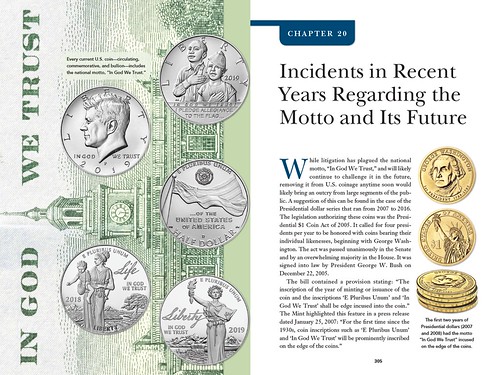
Historian Q. David Bowers, former president of the American Numismatic Association, calls In God We Trust “One of the most detailed, intricate, and fascinating books in the field of American numismatics—and in American history in general.” On the author's style, Bowers says, “Bierly approaches the subject respectfully on all sides, with color, personality, dashes of humor, and dogged pursuit of the truth.”
In God We Trust: The American Civil War, Money, Banking, and Religion
By William Bierly; foreword by Q. David Bowers
ISBN 0794845282
Hardcover, 6 x 9 inches, 352 pages, full color
Retail $29.95 U.S.
https://www.whitman.com/store/Inventory/Detail/In-God-We-Trust+0794845282
About the Author
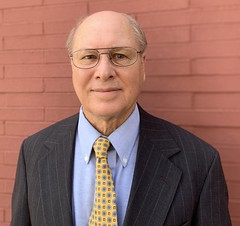 William (Bill) Bierly was raised on a farm near
Walkerton, Indiana. As a child he heard stories from his grandparents about two of his great-grandfathers who had served in the Civil War. This led to a lifelong interest in that war and that period
of history. At about age eight he began collecting coins from circulating change. Following high school Bierly attended Northwestern University for two years and then completed a degree in sociology
and economic development with a minor in Chinese studies at Indiana University. He then worked in India for two years as a Peace Corps volunteer in a dairy development project. Back in the United
States his interest in coins was rekindled. He soon went abroad again, working for three years in Osaka, Japan. Then in the United States he operated a small business for five years, sold it, and
entered graduate school, earning an MBA in finance from Indiana University and embarking on a 25-year career in commercial banking. With his overseas experience Bierly focused on international
banking, particularly Japanese corporate business and Asian correspondent banking. He began his career at National Bank of Detroit and he worked with J.P. Morgan Chase for much of his career; at
various times at the bank's Detroit, Chicago, and Columbus, Ohio, offices, as well as traveling often to Asia.
William (Bill) Bierly was raised on a farm near
Walkerton, Indiana. As a child he heard stories from his grandparents about two of his great-grandfathers who had served in the Civil War. This led to a lifelong interest in that war and that period
of history. At about age eight he began collecting coins from circulating change. Following high school Bierly attended Northwestern University for two years and then completed a degree in sociology
and economic development with a minor in Chinese studies at Indiana University. He then worked in India for two years as a Peace Corps volunteer in a dairy development project. Back in the United
States his interest in coins was rekindled. He soon went abroad again, working for three years in Osaka, Japan. Then in the United States he operated a small business for five years, sold it, and
entered graduate school, earning an MBA in finance from Indiana University and embarking on a 25-year career in commercial banking. With his overseas experience Bierly focused on international
banking, particularly Japanese corporate business and Asian correspondent banking. He began his career at National Bank of Detroit and he worked with J.P. Morgan Chase for much of his career; at
various times at the bank's Detroit, Chicago, and Columbus, Ohio, offices, as well as traveling often to Asia.
While thus engaged, Bierly continued to pursue his coin hobby, eventually specializing in Civil War–era coinage, in particular pattern coins. Today he is active in several coin groups and clubs, most notably the Central States Numismatic Society, the American Numismatic Association, the American Numismatic Society, the Chicago Coin Club, the Michigan State Numismatic Society, and the Pennsylvania Association of Numismatists, as well as the Civil War Token Society and the Liberty Seated Collectors Club. He sometimes exhibits his collection at major coin shows and frequently volunteers as an exhibit judge.
Bierly resides in LaPorte, Indiana. He has two children, Emma and Ken, as well as a granddaughter, Kiki.
To read the earlier E-Sylum articles, see:
NEW BOOK: IN GOD WE TRUST (https://www.coinbooks.org/v22/esylum_v22n41a04.html)
BOOK REVIEW: IN GOD WE TRUST (https://www.coinbooks.org/v22/esylum_v22n42a07.html)
SHANNA SCHMIDT ON NUMISMATIC LIBRARIES
In her email Newsletter #144 this week, dealer and ANA board member Shanna Schmidt discusses her numismatic reference library and the little gems found within. With permission, we're republishing her note here. Thanks! -Editor
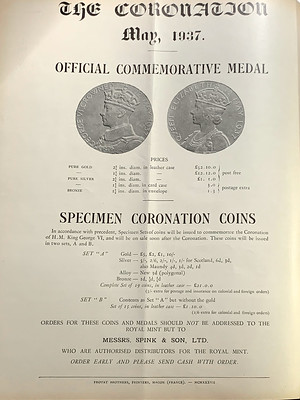 Hello everyone! I hope you all had a nice week. It was
pretty quiet around here so I was able to catch up a bit on my own coin inventory and library. Speaking of books, most of you are aware that I am on the quest to achieve a top notch numismatic
working library. Unfortunately for my family the books are starting to spill into nearly every room in our small house. Aside from being able to peruse old auction catalogs in searching for pedigrees
or research new inventory or possible customer purchases in auctions, the books also provide me an interesting window into the past.
Hello everyone! I hope you all had a nice week. It was
pretty quiet around here so I was able to catch up a bit on my own coin inventory and library. Speaking of books, most of you are aware that I am on the quest to achieve a top notch numismatic
working library. Unfortunately for my family the books are starting to spill into nearly every room in our small house. Aside from being able to peruse old auction catalogs in searching for pedigrees
or research new inventory or possible customer purchases in auctions, the books also provide me an interesting window into the past.
Today I was putting my catalogs in better order making labels of different auction houses. I keep some of the older ones right next to my desk but others just don't fit so they go downstairs on shelves. I was returning a Spink catalog to the shelf when I decided to pull out the Spink Numismatic Circular from 1936/7 to which I have hard bound books. Just from paging through it I was able to see that some great numismatists had passed away in that year (Albert Henry Baldwin, Max von Bahrfeldt, Michael Vlasto and Percy Webb to name just a few).
I also noticed some interesting books that were just published in 1936. One was Les Poulains de Corinthe by Oscar E. Ravel which I use in my own library. Another was Treasure Trove in Law and Practice: From the Earliest Time to the Present Day by Sir George Hill who was the outgoing director of the British Museum. In that same year Mr. Hill left the British Museum after 41 years of service. Some of his accomplishments (in his words): “allowing people to smoke in the quadrangle and planting almond trees on the grass lawns in front of the museum”.
There was also a string of articles composing a work on the Portraits of Royal Ladies on Greek Coins. I suppose my favorite discovery was an advertisement for the Coronation medal from May 1937 of H.M. King George VI and his wife Queen Elizabeth (for those not familiar with the Royals, the parents of the current monarch). All this information in one book and the crazy thing is that most of the academics and their works are still very relevant today.
To subscribe to Shanna's newsletters, see her web site:
https://www.shannaschmidt.com/
ROBERT MARTIN CONNECTICUT COPPER NOTEBOOKS
The latest addition to the Newman Numismatic Portal is the Robert Martin Notebooks on Connecticut Coppers. Project Coordinator Len Augsburger provided the following report. -Editor
American Numismatic Society Library Acquires Robert Martin Notebooks on Connecticut Coppers
Through the generosity of Syd Martin, Roger Siboni, and Tony Terranova, the ANS library has acquired the Robert Martin notebooks on Connecticut coppers. These recently appeared in the Stack's November 2019 Baltimore sale (lot 5056), and are there described in part
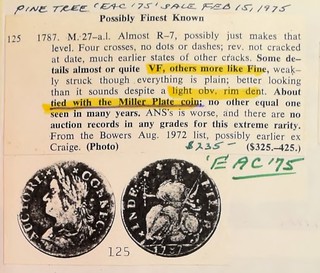 “These eight binders represent Robert's
life's work—nearly five decades of research on the Connecticut copper series. Robert would copy, cut and paste onto sturdy 8.5”x11” 3-hole punched pages auction appearances, fixed price listings,
reports from fellow collectors, images, emails, articles, photocopies from the Hall manuscripts and just about any information he could find about Connecticut coppers—die marriages, history, and
technical details.”
“These eight binders represent Robert's
life's work—nearly five decades of research on the Connecticut copper series. Robert would copy, cut and paste onto sturdy 8.5”x11” 3-hole punched pages auction appearances, fixed price listings,
reports from fellow collectors, images, emails, articles, photocopies from the Hall manuscripts and just about any information he could find about Connecticut coppers—die marriages, history, and
technical details.”
The value of this material is self-evident, and anyone collecting or researching Connecticut coppers will find much of interest. These eight binders have been digitized at ANS and are now available on Newman Portal.
Image: Sample page from Robert Martin notebook 4, depicting condition census M. 27-a.1 Connecticut copper.
Link to Robert Martin notebooks on Newman Portal:
https://nnp.wustl.edu/library/archivedetail/536317
U.S. CONGRESSIONAL REPORTS ON NEWMAN PORTAL
Other new additions to the Newman Numismatic Portal are the U.S. Congressional Reports. Project Coordinator Len Augsburger provided the following report. -Editor
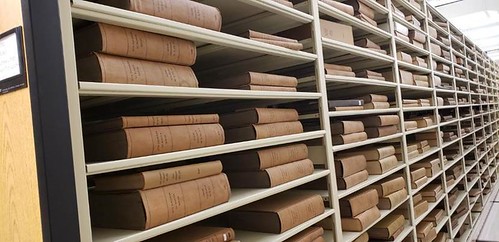
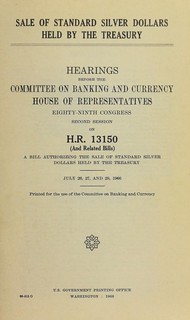 The congressional serial set, essentially the
proceedings of the U.S. Congress for over 200 years, runs on the order of 20,000 volumes, a challenge most collectors would not even think to attempt. While this content has been digitized by
ProQuest and others, most of it resides behind firewalls, and typically only academic libraries have access. Numismatic literature collectors typically encounter this material in the form of reports
running several pages, which been extracted from bound volumes.
The congressional serial set, essentially the
proceedings of the U.S. Congress for over 200 years, runs on the order of 20,000 volumes, a challenge most collectors would not even think to attempt. While this content has been digitized by
ProQuest and others, most of it resides behind firewalls, and typically only academic libraries have access. Numismatic literature collectors typically encounter this material in the form of reports
running several pages, which been extracted from bound volumes.
Washington University in St. Louis, a federal deposit library, holds a hardcopy of the entire set, and the Newman Portal has been scanning the bits of interest to numismatists. This material include legislation related to the production of coins and medals and well as formal reports on various coinage matters. A 1966 report, for example, discusses the sale of silver dollars from the U.S. Treasury, which throughout the 1960s and 1970s had significant impact on the numismatic market.
Images:
- cover of “Sale of Standard Silver Dollars Held by the Treasury,” 86th Congress, July 26-28, 1966.
- Small portion of the Congressional serial set in the Washington University library stacks.
Link to U.S. Congressional Serial Set on Newman Portal:
https://nnp.wustl.edu/library/publisherdetail/512550

THE HOWARD D. GIBBS ARCHIVES
Bob Leonard mentioned another recent Newman Portal addition in the February 2020 issue of the International Primitive Money Society newsletter: the archives of primitive money collector Howard D. Gibbs of Pittsburgh. -Editor
IPMS friend Wayne Homren advises, “I have an archive of material from Odd and Curious Money collector Howard Gibbs of Pittsburgh. I shipped everything to the Newman Numismatic Portal and it's been digitized: https://nnp.wustl.edu/library/archivedetail/533970.”
While somewhat spotty in the early years, this archive covers 1927-1973, but the Zoom in feature will need to be used to read them. The first entry, dated to 1927, actually houses a letter written in 1968, however. But the next is a letter from Dr. J. van der Hoop, Batavia, Netherlands East Indies, written August 8, 1938, concerning the acquisition of two brass drums from Alor, shipped to him at the “Pittsburgh Numismatic Museum” July 29, 1939.
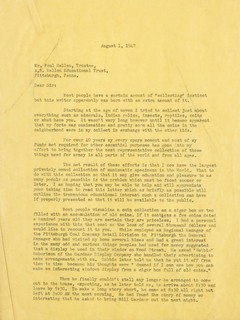 One of the most interesting items is Gibbs's letter of
August 1, 1947, describing his collection and providing anecdotes of how he obtained certain items (he hoped that philanthropist Paul Mellon would acquire the collection and house it in a museum, but
this never happened and the Gibbs Collection was broken up and sold in a series of Hans M. F. Schulman auctions).
One of the most interesting items is Gibbs's letter of
August 1, 1947, describing his collection and providing anecdotes of how he obtained certain items (he hoped that philanthropist Paul Mellon would acquire the collection and house it in a museum, but
this never happened and the Gibbs Collection was broken up and sold in a series of Hans M. F. Schulman auctions).
The 1955 file contains fascinating details of Gibbs' partnership with Schulman, with prices, comments on buyers, etc.
I have not had time to review the entire archive, but it has information on the sources of many pieces, of interest to collectors having material with Gibbs pedigrees.
I'm probably to blame if any of the Gibbs papers are misfiled. The archive arrived as a mess - I'd collected it from the home of fellow Western Pennsylvania Numismatic Society member Emerson Smith, working one room ahead of a crew tossing everything left into a dumpster. It was my "if Indiana Jones Were a numismatist" moment, grabbing things in a near panic before catching the last chopper out of Saigon.
The Mellon letter is my favorite, too. I also recall learning from my friend Glenn Mooney, who was a volunteer at the Carnegie Museum of Pittsburgh's coin collection, that one day a box addressed to the “Pittsburgh Numismatic Museum” was mistakenly delivered to Carnegie Museum instead of Gibbs' home - that was when they learned that many of Gibbs' correspondents around the world thought they were giving or selling coins to an actual museum. -Editor
To check out the Gibbs archive on the newman Numismatic Portal, see:
Howard D. Gibbs Archives (https://nnp.wustl.edu/library/archivedetail/533970)
For more information on the International Primitive Money Society, see:
https://www.facebook.com/internationalprimitivemoneysociety/
Bob adds:
"We issue a newsletter three times a year and meet once or twice a year at conventions. We have a meeting at the National Money Show in Atlanta and will meet again in Pittsburgh. Dues are a ridiculously low $5 per year, payable as $10 for two years to Carl Wolf, IPMS, 1055 W. Bryn Mawr Ave., #F-335, Chicago, IL 60660."
VIDEO: NSDR PRESIDENT JEFF WULLER
These are selections from the David Lisot Video Library that feature news and personalities from the world of coin collecting. David has been attending coin conventions since 1972 and began
videotaping in 1985. The Newman Numismatic Portal now lists all David's videos on their website at:
https://nnp.wustl.edu/library/multimediadetail/522852
Here's one with National Silver Dollar Roundtable President Jeff Wuller at the January 2020 FUN show, together with Lincoln impersonator Dennis Boggs. That Lincoln guy is great at speechifyin'... -Editor
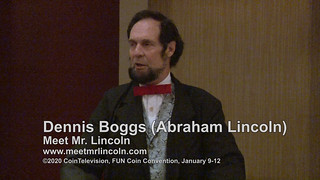 NSDR President Jeff Wuller Gives Opening
Remarks and Goals for 2020.
NSDR President Jeff Wuller Gives Opening
Remarks and Goals for 2020.
Jeff Wuller, President, National Silver Dollar Roundtable
The 2020 NSDR started by a special prayer delivered by Abraham Lincoln (Dennis Boggs). President Jeff Wuller the talked about his goals for the National Silver Dollar Roundtable.
An excerpt of the video is available for viewing on the Coin Television YouTube Channel at:
https://youtu.be/L02cI7WM6lo
QUERY: CENTRAL AMERICAN FEDERATION COUNTERSTAMP
Researcher Roberto Jovel is seeking information on counterstamped coinage for the short-lived sixth State of Los Altos, Guatemala. -Editor
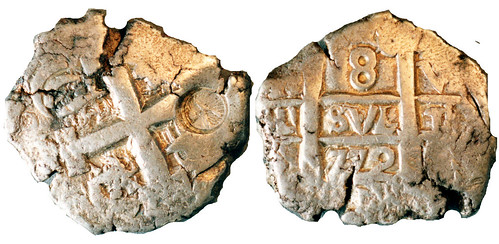
I am presently expanding and updating the analysis of the coinage countermarked with the short-lived sixth State of Los Altos (1838-1840) in the Central American Federation stamp. The original analysis was included as part of the 2001 book entitled Necessity Coins of Guatemala.
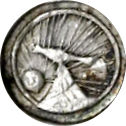 For that purpose, I am collecting images
and information on existing coins with the Quetzal bird over volcano and radiant sun countermark and have so far just over 50 examples (See image of the countermark). They include host coins minted
since Spanish monarch Philip III through the post-independence Republican period; from Mexico, Guatemala, Potosi and Lima mints, and on denominations of 2, 4 and 8 Reales.
For that purpose, I am collecting images
and information on existing coins with the Quetzal bird over volcano and radiant sun countermark and have so far just over 50 examples (See image of the countermark). They include host coins minted
since Spanish monarch Philip III through the post-independence Republican period; from Mexico, Guatemala, Potosi and Lima mints, and on denominations of 2, 4 and 8 Reales.
I would like to enlist the assistance of those collectors in the United States that may have such rare coins, and who could provide images and full particulars of them for inclusion in the updated and expanded analysis. Due credit would be given to collectors who provide information, in the manner of their preference. Any information may be sent to the following e-mail: rjovel@jovel.org
MORE ON THE FUGIO CENTS IN LUCITE
Last week Roger Siboni discussed the Bank of New York Fugio Cents encased in Lucite, and requested more information: "When were these made? How many?. For how long? Did they know what they were encasing was valuable (was it then?). About how many remain? I know I tried to acquire one through BONY in the early Nineties and they told me they ran out years ago."
First to respond was Len Augsburger of the Newman Numisamtic Portal. -Editor
I note that Stack's sold one of these in 2002:
https://archive.org/details/americanacolonia2002stac/page/21/mode/2up (lot 280)
This one was engraved COMMERCIAL CREDIT COMPANY 1934-1959 / LEBARON S. WILLARD JR. while Roger's is engraved WYATT INDUSTRIES / 50th ANNIVERSARY / FEBRUARY 5, 1913 – FEBRUARY 5, 1963 / W. B. VAN WART / CHAIRMAN OF THE BOARD.
I'm guessing every example was uniquely engraved.
There is also one in Stacks/Bowers 3/2011, lot 227 (realized $4,025).
I'm embarrassed to say we don't have this catalog on Newman Portal (I can tell what happened – the Stack's online archive, which we copied, has the March catalog, but it's the SB/Ponterio sale not
the SB sale – for this sale we have to scan the actual hardcopy). But, I found the lot on the Stack's site –
https://auctions.stacksbowers.com/lots/view/3-286OU/1787-fugio-copper-pointed-rays-w-6740-newman-8-b-urs-12-united-states-4-cinquefoils-ms-60-cleaned-uncertified
This one is engraved 25th Anniversary / 1933-1958 / H. A. Eddins. Google tells us Eddins was president of the Gas Association.
And so far, we can date them to the late 1950s / early 1960s.
Dave Bowers further discusses these in American Coin Treasures and Hoards (p. 29), noting that 50 or 60 were encased in lucite. This estimate probably came from Tony Terranova.
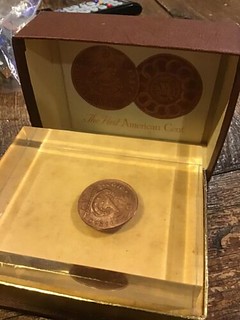 Tony Terranova of New York City writes:
Tony Terranova of New York City writes:
"These were made for presentation purposes to important clients and long term employees of the bank. The unengraved ones were the leftovers from when the bank stopped the practice.
As of mid 1991 when I curated the leftover hoard, there were 56 of those Lucite blocks among a total of 819 in various mint state shape. Many were water damaged, from a partial flood in the basement vault where they were stored."
Thanks! -Editor
To read the earlier E-Sylum article, see:
BANK OF NEW YORK FUGIO CENTS IN LUCITE (https://www.coinbooks.org/v23/esylum_v23n07a16.html)

NOTES FROM E-SYLUM READERS: FEBRUARY 23, 2020
Numismatic Friends of Sherlock Holmes Dinner in Atlanta
Greg Ruby writes:
"The American Numismatic Association will be holding its National Money Show at the Cobb Galleria Centre in Atlanta from Thursday, February 27 thru Saturday, February 29. The Fourth Garrideb, the Sherlockian group of coin collectors or the coin club with Sherlock Holmes fans, will be in Atlanta to take part in the activities
"We would like to invite our members, along with our friends and guests to join us for our semi-annual Numismatic Friends of Sherlock Holmes Dinner on Thursday, February at 7 p.m. The venue is Maggiano's Little Italy, located at 1601 Cumberland Mall, a short distance from the Cobb Galleria Centre. Dinner will be served family style and separate checks will be presented to each attendee. There is no need to pay in advance. Cost is $34.99 for dinner, plus tax and gratuity. Adult beverages are also available for those so interested."
To read the earlier E-Sylum article, see:
Numismatic Friends of Sherlock Holmes Dinner in Atlanta February 27
(https://fourthgarrideb.com/2020/02/05/numismatic-friends-of-sherlock-holmes-dinner-in-atlanta-february-27/)
1792 Disme Project Thoughts
Bill Eckberg writes:
"I look forward with great anticipation to see what Rob Rodriguez and Tony Lopez have found in the silver dismes. A few years ago, I discovered and reported in The Numismatist (June, 2017), that the 1792 disme obverse was created from a hub (device punch) that was later used in 1793 to create the two half cent obverses.
"It's also interesting that all three specimens seem to have circulated to some extent, as did many of the copper specimens. The latter most likely circulated at the value of a half cent, since they are about the same size, but it is hard to guess at what value a silver disme circulated."
To read the earlier E-Sylum article, see:
1792 SILVER DISME PROJECT ANNOUNCEMENT (https://www.coinbooks.org/v23/esylum_v23n07a11.html)
Thanks. -Editor
To read the earlier E-Sylum article, see:
GEORGE MEDAL FOR SAVING PRINCESS ANNE (https://www.coinbooks.org/v23/esylum_v23n06a31.html)
Query: 1795 Dollar Badge Whereabouts Sought
W. David Perkins of Centennial, CO writes:
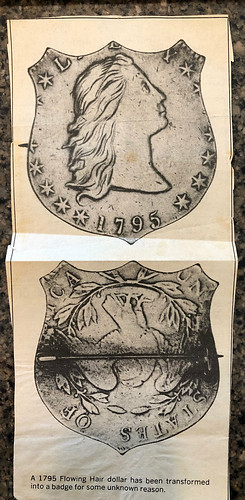 "Yesterday I was going through a box
of early dollar items and came across this clipping, likely originally from Coin World or Numismatic News. The clipping / photo is undated. It was found in a group of items given to me
by the late Bob Stark, an early dollar collector, researcher, and author.
"Yesterday I was going through a box
of early dollar items and came across this clipping, likely originally from Coin World or Numismatic News. The clipping / photo is undated. It was found in a group of items given to me
by the late Bob Stark, an early dollar collector, researcher, and author.
"The photo is of a 1795 Flowing Hair Silver Dollar with 3 Leaves under the eagle's wings, “transformed into a badge for some unknown reason” as captioned.
"The coin appears to grade Extra Fine details, “plus or minus.” This would roughly be a $15-20,000 coin today if graded Extra Fine and in a holder! But it would not be as the hair is reengraved.
"It appears to be struck from the relatively common BB-27, B-5 die marriage. Thank goodness it is not struck from an extremely rare die marriage...
"If anyone has seen this item “in person” or knows anything about it please contact me at my e-mail address: wdperki@attglobal.net "
Interesting and strange item. Has anyone seen it? The text does not show up in a Newman Portal search. Since Coin World has been digitized but Numismatic News has not, it seems more likely that this is from Numismatic News. If that periodical gets digitized someday, perhaps we'll be able to locate the exact issue where this came from; perhaps it was part of a larger article and more information will be found there. -Editor
SEARCHING FOR ONE MERCURY DIME TYPE COIN
Jeff Burke submitted this article on his search for just the right coin for his type collection. Thanks. -Editor
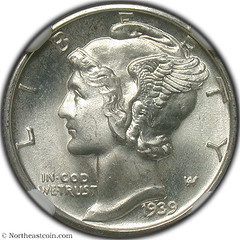
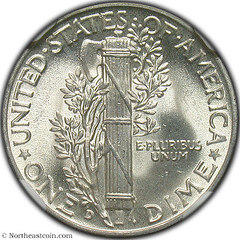
Introduction
I have fond memories of my maternal grandmother, May Rohlfs, taking shiny Mercury dimes from her small red change purse in the late 1960s to give her young grandson for his budding coin collection. I remember May's smile when I expressed awe at first examining these tiny coins.
I've read several books and numerous articles about Mercury Dimes. I previously owned a beautiful 1921 Mercury Dime NGC AU58 that I purchased on e-bay from Harbor Coin Company in Winthrop Harbor, IL in 2006. I sold this coin to purchase a high-grade early copper half cent in 2015.
I am continuing to collect the most well-struck and my favorite U.S. type coins for my collection. I began with locating a Saint-Gaudens Double Eagle - 1923-D NGC MS 65*. My next focus is a 1939-D Mercury Dime. Then I will move onto a Buffalo Nickel, Walking Liberty Half Dollar and a Morgan Dollar.
Conducting Research
After considering various alternatives, I decided to pursue a high-grade Mercury Dime with full bands. I ended up targeting 1939-D specimens. My favorite reference for researching this series is The Complete Guide to Mercury Dimes, 2nd Edition, by David Lange, published in 2005. There, Lange writes “This issue [1939-D] is the quintessential type coin, being perhaps the most consistently attractive Mercury Dime in the entire series. [The] 1939-D has graced many a high- grade type set, including the famous Knoxville collection.” (p. 176). The date of 1939 also made me reflect on the start of World War II and other events in world history that year.
Before perusing dealer websites for a 1939-D dime, I read through informative Mercury dime threads on the PCGS and NGC Message Boards. I found a number of auction catalog and numismatic periodical listings for the 1939-D Mercury dime on the Newman Numismatic Portal. It was also instructive to read through NGC and PCGS Price Guides and auction archives.
Making the Purchase
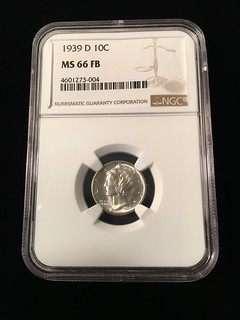 I noticed the price jumps significantly for the
1939-D dime between MS66 FB and MS67 FB. After examining over 60 1939-D specimens in the MS 64-69 FB range, I decided to narrow my search to a 1939-D Mercury dime in MS66 FB. I finally chose a 1939-D
Mercury Dime NGC MS66 FB from Northeast Numismatics in Concord, MA. This lovely coin arrived in the mail today (2/12/20). I was thrilled to have a Mercury dime with shimmering luster! It looks like
it was minted yesterday instead of 81 years ago.
I noticed the price jumps significantly for the
1939-D dime between MS66 FB and MS67 FB. After examining over 60 1939-D specimens in the MS 64-69 FB range, I decided to narrow my search to a 1939-D Mercury dime in MS66 FB. I finally chose a 1939-D
Mercury Dime NGC MS66 FB from Northeast Numismatics in Concord, MA. This lovely coin arrived in the mail today (2/12/20). I was thrilled to have a Mercury dime with shimmering luster! It looks like
it was minted yesterday instead of 81 years ago.
Note: Chris Clements of Northeast Numismatics kindly provided obverse and reverse images of my Mercury dime to accompany this article.
VOCABULARY TERM: IMPRESSED DESIGN
Dick Johnson submitted this entry from his Encyclopedia of Coin and Medal Terminology. Thanks. I added the images of the C. D. Peacock medal, found on the Goldberg's site. -Editor
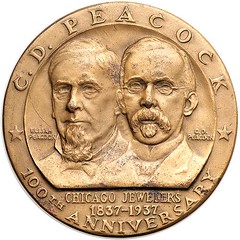
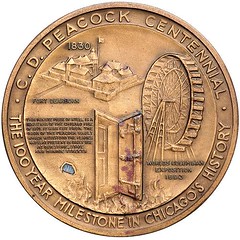
https://www.goldbergcoins.com/view-auctions/catalog/id/33/lot/69075
Impressed Design. An added piece of metal or other very hard substance which by intent is laid on the surface of a blank or partially struck medal and is pushed into its surface by the blow of the press and the striking of the dies. Impressed objects are much like an inlay – appearing below the surface – by placing it there before the final blow (this is easy to do with open face dies, but difficult in coining). Impressed objects are subject to flaking off, so care must be taken in their handling. When such an object is not inlaid by design it is an anomaly called impressed error (see next entry).
The first evidence of this occurred in 1692. Trial halfpennies and farthings of William and Mary were struck with impressed metal shapes. A halfpenny exists with a mullet-shaped or circular tin center impressed in a copper coin; or an 8-pointed star in copper impressed in a tin coin. The farthings had a ring of brass impressed in a copper coin. According to C. Wilson Peck, of the British Museum, the reason is unknown why these few trials were made. A similar ancient technique was used in Etheopia as early as AD 380, and in China for a special 5,000 ch'ien coin in AD 7
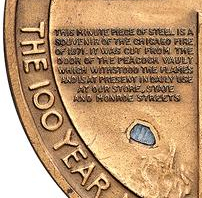 This is the method of
manufacture for an occasional relic metal medal in modern times. An example is the C.D. Peacock 100th Anniversary Medal of 1937. This medal contains a minute piece of the firm's steel safe door
impressed into the lower reverse field. The safe had survived the 1871 Chicago Fire and was still in use in 1937.
This is the method of
manufacture for an occasional relic metal medal in modern times. An example is the C.D. Peacock 100th Anniversary Medal of 1937. This medal contains a minute piece of the firm's steel safe door
impressed into the lower reverse field. The safe had survived the 1871 Chicago Fire and was still in use in 1937.
References:
NC7 {1960} Peck, pp 158-9.
Looking for the meaning of a numismatic word, or the description of a term? Try the Newman Numismatic Portal's Numismatic Dictionary at: https://nnp.wustl.edu/library/dictionary
Or if you would like a printed copy of the complete Encyclopedia, it is available. There are 1,854 terms, on 678 pages, in The Encyclopedia of Coin and Medal Technology. Even running two a week would require more than 19 years to publish them all. If you would like an advance draft of this vital reference work it may be obtained from the author for your check of $50 sent postpaid. Dick Johnson, 139 Thompson Drive, Torrington, CT 06790.
KUNZE, REV. JOHANN CHRISTOPH (1744-1807)
Kunze, Rev. Johann Christoph (1744-1807), sometimes Anglicized and spelled in the literature as John Christopher Kunze. He is among the earliest known numismatists in 18th century America and a contemporary of Pierre Eugene Du Simitiere (q.v.).
A German scholar of Hebrew, Kunze came to America in 1770 from England where he sailed from Halle, Germany. He was a Lutheran pastor at the Friesburg Emanuel Lutheran Church, Philadelphia. In 1773 he founded and established a German secondary school (Seminarium). In 1780 the school became the German language department of the infant Pennsylvania University. Hebrew was added to the curriculum but no students enrolled for either language. Kunze's language institute disbanded and was superseded by Franklin College in Lancaster.
Kunze's 1781 edition of the Lutheran Catechism together with that of Henrich Miller's edition of 1774 laid the foundation for the first edition of the authorized version of the Pennsylvania Ministerium catechism.
He went to NY in 1784 to teach at Columbia College. In 1786 Johann Samuel Schwerdtfeger assisted Kunze and Heinrich Moller in organizing the New York Ministerium, the second Lutheran synod in the United States. As a New York coin collector he donated to the New York Historical Society. Unfortunately, according to Kelby in 1905, his coin collection was stolen from the New York Historical Society.
His coin cabinet contained 900 coins of which 30 are gold, 400 silver, 475 copper and bronze. Among his coins are included ancient Roman, medieval and modern European and various pieces of Early American colonial New England Bay Colony silver coinage of 1652, a St. Patrick farthing, a Rosa Americana, and a Voce Populi.
Kunze had a policy where he put his duplicate coins in a chest allowing anyone to take what they pleased as long as they replaced the coin with one not in his collection.
As a writer he is credited in Dr. Morris' Bibliotheca Lutherana with eight books of which he was the author or editor, from Hymns and Poems to A History of the Lutheran Church and A New Method of Calculating the Great Eclipse of 1806.
To read the complete article, see:
KUNZE, JOHANN CHRISTOPH
(https://sites.google.com/a/numismaticmall.com/www/numismaticmall-com/kunze-johann-christoph)

STACK'S BOWERS ON THE MOVE IN NEW YORK
It's the end of an era - Stack's Bowers is moving from the decades-long home of Stack's at 123 West 57th Street. Here's the press release. -Editor
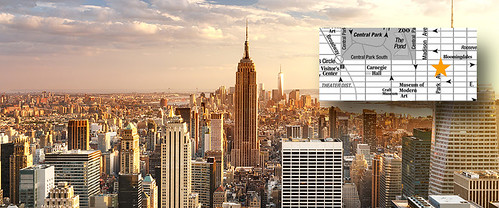
Stack's Bowers Galleries is moving to a new, larger location at 470 Park Avenue in the spring of 2020. In the meantime, we will be at our temporary location:
Americas Tower
1177 Avenue of the Americas
5th Floor
New York, New York 10036
Please contact us to schedule an appointment:
Toll Free: 800.566.2580
E-mail: NYC@StacksBowers.com
The building at 123 West 57 th Street that was the historic location of Stack's Bowers has been sold to real estate developers with future plans for the space. For 67 years, this location housed the operations of the Stack family and organization and has been a numismatic landmark in New York City. Collectors from all over the world would congregate at the office to visit and talk coins, whether they were buying, selling or participating in auctions.
Harvey Stack recalls in early 1953 when his father, Morton, and his Uncle Joseph moved the firm to its current location. “I was in charge of seeing that all the packing was secure, placed on lift-back trucks and rode shot-gun to the new store. We transported show cases, safes, file cabinets, coin cases, rare coins, bags and rolls of our extensive inventory, our library and the numismatic documents that framed our walls. Our new location was surrounded by two classic hotels, the famous Steinway Hall, the world famous Carnegie Hall, the Russian Tea Room, and more.”
The next chapter in the Stack's Bowers New York story is about to begin with a beautifully remodeled space in the heart of Manhattan, just a few blocks away at 57 th and Park Avenue. Construction is currently underway, and a spring opening is planned. Announcements will be forthcoming as progress continues.
For more information contact Mark Schimel at mschimel@stacksbowers.com or at 800-566-2580.
Harvey Stack kindly provided these draft recollections of Stack firm's homes over the years including the fabled W. 57th Street storefront. Thanks! -Editor
As many, many collectors have come to call Stack's and now Stack's Bowers a NUMISMATIC LANDMARK on West 57th Street in New York City, The Stack's Bowers shop and showroom has to move East to Park Avenue and 58th Street, still in the luxury and classic area of Manhattan.
Going back in time, Stack's opened its full retail Coin Shop in New York, after moving up for the Bowery Area in 1933. (The Bowery Area was and still is a Jewelry center, a hock shop area, and other related businesses.)
IN 1933 Stack's decided to move north in Manhattan to 690 Sixth Avenue, near 23rd Street and Sixth Avenue. It was then in the center of Mid - Mahattan transportation at the time, with the 6th Avenue Elevated train at the corner close to the Subway at 7th and Broadway, a block from Fifth Avenue,and close to a maze of fine shopping on Fifth Avenue. It was in a hub of shops that had moved North in Manhattan, as fine residences moved in the same direction.
Only a few Numismatic shops were in Manhattan, but a number of old, classical Numismatic Dealers had office space nearby.
The new shop on 6th Avenue attracted many collectors, a place to buy and sell coins, get advice about collecting. It was here that the Stack Family nurtured the Coin Business in New York. Many collectors visited Stack's shop and met many collectors and dealers ,who had a "home away from home" to sit at counters and discuss Numismatics.
Many a fine and classic collection were started and developed on Sixth Avenue, which include Louis E. Eliasberg, Col. E. H.R. Green, F.C.C. Boyd, Harold Bareford, and most members of the various Numismatic Clubs that surrounded Manhattan, namely the New York Numismatic Club, Bronx Coin Club, Brooklyn Coin Club, Long Island Coin Club, Westchester Coin Club. to mention but a few that developed or were in existence already after the great depression in the early 1930's.
By 1935 Stack's decided to start having PUBLIC COIN AUCTION SALES a source of providing a new market for coins to this growing audience. We were able to offer 4 different auction sales, of specialized collections and general numismatic items of the United States, in 1935 as well as specialized collections of Foreign and Ancient Coins and currency. Our sales became a monthly attraction for the collectors, who traveled to attend from as far away as Baltimore, Philidelphia and Boston, and nearby Connecticut. It was a great place to find fellow collector, many who became close friends.
We followed in 1936 with 10 Public Auctions, and maintained that number on average for many many years. We were so well entrenched in the coin auction business, that we were invited and conducted the first public auction sale in conjunction the 1939 World's Fair held in New York, in that summer , as the American Numismatic Association also held its Annual Convention in New York.
For the last 85 years Stack's and its associated firm, led by Dave Bowers since 2006,has provided almost every year a sensational offering of Coins at Public Auction in all series,U.S. Foreign and Ancients, in all metals , and paper currency. As of this year , we have conducted over 800 sales, many which contained classic and rarities not offered by others, world wide.
In 1937 we decided, as many of the finer shops kept moving uptown in New York, we moved our location to 32 West 46th Street, just West of Fifth Avenue. It was a larger location from our 690 Sixth Avenue location had show room that could not only be available to serve our many collectors and friends, but even we also used it as our auction room monthly. Everyone found us easily, and we had all we needed to make them comfortable. We offered sit-down show cases to make the visitor as comfortable as we could. Any of our major sales were also held at various hotels nearby when we expected a larger audience.
Norman Stack, my uncle Joseph B. Stack 's, younger son, (who was 3 weeks younger than me) and Benjamin Stack, J. B's older son,( one year older than me) along with myself,(whose father was Morton Stack, ) were called to duty on any of the weekends to sort, file, clean up the store , help where we could manage our active trade, and all three of us got to know most of the famous collectors at the time, and from learned about the fine art of being a numismatic dealer. It was a great learning opportunity. The two seniors, Joseph and Morton engaged some of the younger collectors as well to help us with our chores. Many were with us till World War II began, among the famous ones were Cornelius Vermuele, and John J Ford, Jr., each who spent time with us. They too provided great insights and learning to all of us.
With the war enlisting many young men into service, in 1942 John ended up in the Army in the transportation division,and Corny ( to his friends) who had a knack with oriental language, mostly Japanese, was in the Finance Division,and with Norman Jacobs did the inventorying and records of the vast holdings by the Bank of Japan. From their studies wrote one of the first books about Japanese coins in English, which Stack's published for them, and was the beginning for many of our soldiers who served and returned from Japan after the war, to learn about the Asian coins they acquired and start to collect.
Our offices on 46th Street moved again, in 1945 after we bought a two story building at 12 West 46th Street, which provided a large retail shop, and a second floor location for our cataloguers and general office staff, as well as a large auction room for our virtually monthly sales.
We remained at this great location, again near 5th Avenue, one block south of the Jewelry Center on 47th Street, and with next door neighbors such as Botney Woolens, and Burleigh Brooks. Again our offices was a "Club House" for collectors and dealers. A number of smaller dealers occupied office space and shops near our location, such as Lester Merkin, New Netherlands (who took over the space that Scott Stamp and Coin Company had on 47th Street ) and Hans Schulman., to mention a few. However ,Stack's was the first attraction that most collectors visited first. Though we were competitors we were able to work closely with all of the dealers, and retained friendships for many decades.
In l951 we met a new collector of Gold Coins. He was Josiah K.Lilly. chairman of Eli Lilly & Co, who decided to show some interest in Spanish Colonial Gold Coins, a series he studied and read about in the literature he collected, He built in his lifetime one of the most complete collection of books and manuscripts of Early English and America ever assembled, (now part of the Lilly Library at Indiana University). He was amazed that we were able to show him a sizeable offering of Cobs and portrait examples from the various countries, of actual Spanish colonies that existed in the Western Hemisphere. This first encounter lead to our building over the next 16 years the most famous WORLD CLASS GOLD COIN COLLECTION, numbering over 6500 different gold coins of the World, including a virually complete collection of UNITED STATES GOLD COINS. FROM 1795 TO 1933, PLUS one of the most extensive collections of Pioneer and Territorial Gold collections ever assembled. It was a chore we all enjoyed, and when we needed assistance from our fellow dealers to build and complete his collection, we engaged many like Hans M.F.Schulman and others to help us complete our assignment. Stack's through each of the generations worked with and built and later sold many of the famous and noteworthy collections formed. Our family dedication was to keep Numismatics growing !!! The Josiah K. Lilly Gold Coins of the World, was acquired from his Estate after he died in 1967,for our National Numismatic Collection at the Smithsonian, by an Act of Congress, for some Five and a Half Million Dollars, a sum, far in excess of the original cost, and a major acquisition of coins at that time .The addition to our National Collection made by this purchase of the Lilly Collection,made our National Collection the major World Class Numismatic Collection in existence. All the gold coins in the Lilly Collection were acquired and supplied solely by the STACK FAMILY. A proud accomplishment for our company. !
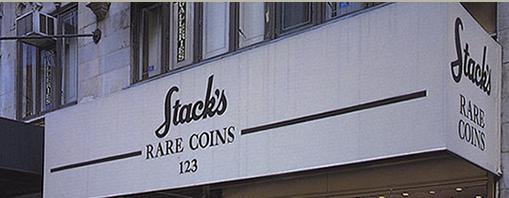
By 1953 ,we realized that West 46th had changed in character. Some of the fine luxury shops that surrounded us were taken over by discount houses, selling all types of appliances and T V sets, and the crowds that visited our once calm, dignified street did not attract the people who who were collectors . So we searched for a new location, and since the entire art and special shops moved North a few blocks we found a very unusual shop 123 West 57th Street between Sixth (also called the "Avenue of the Americas") Avenue and Seventh Avenue .
At 123 we found an attractive shop, 100 feet deep as part of the Hotel Salisbury, a semi-residential hotel, owned and operated by the Calvary Baptist Church which was part of the massive piece of real estate they had located their church on in the early 1900's. The location was virtually attached to Steinway Hall, the most famous and largest piano builder in America, which had a huge show room on the first floor for its pianos, and a wonderful gallery on the second floor for small concerts. On the corner of 6th Avenue was the Buckingham Hotel, across the street was a huge apartment house, and going westward one of the last Horn and Hardart Cafeteria's; with its unique glass compartments, (opened by inserting coins.) as well as a diversified hot table one could buy an evening plater; next to the Great Northern Hotel, and then the Russian Tea Room, and then anchored on the corner by the famous CARNEGIE HALL. On our side were a number of fine art galleries and a few restaurants. All together a wonderful place to travel to by Subway.(6th and 7th Avenue Lines} which went North and South on each side of our street into upper and lower Manhattan, a six lane street passing us East and West for bus lines, taxis and private cars. It was a dream location, as 57th Street was also a great "walking Street" just 2 blocks South of luxurious Central Park South, where our Central Park began. The area was a great tourist attraction. What a great site for our New Home. !!!
However , though we were also promised occupancy of the second floor above our shop it would not be available for a couple of years. We found an additional location down the street on the second floor of 37 West 57th, and we moved our foreign and ancient department there, with Dr. and Mrs. Stefanelli as managers, as well as our complete foreign library, and our entire bookkeeping department. We also had an exhibit area for our auction sales. So it was a short distance away , it worked out fine for we knew it would be a temporary arrangement till we could move the Coin Galleries to 123 in a few years.(Since each location had a speciality we used 123 West for buying and selling United States Gold, Silver and copper coins, and COIN GALLERIES for our Foreign and Ancient Clients, and our international coin library.)
IN SPITE OF THE DIFFICULTIES IN MOVING AND RELOCATING AND SETTING UP, THE STACK FAMILY ALONG WITH ITS GREAT STAFF' PRODUCED 7 AUCTION SALES IN 1953, (4 of which were name sales, 2 for the average collector and a Convention Auction Catalog for their meeting in Worchester, Mass in October 1953, which I became the auctioneer of record ! )
We sold our building at 12 W 46th Street for a tidy sum and moved to what became our present location at 123 West 57th . As Norman was already drafted into military service in 1953, and Ben , after a dispute with his father, J.B.,left to try open a coin shop in Las Vegas. we were short Stack Staff. it left only Morton, J.B. and myself to manage the move. J.B. stayed at 57th Street, Morton dispatched the furniture and large coin cabinets from 46th Street, and I "rode shot-gun" on the liftback truck that did the daily moving. It wasn't easy, as they kept 46th Street opened during the move, with our staff managing those who came to buy and sell to us. In spite that the move was accomplished in less than a week. It was a long and tedious job for all. However, we were set up at our two locations and business went forward. Our PHONE NUMBER remained the same, as it was on 6th Avenue and still is the same today, ( 212-582-2580)
Our staff at the time included the Stefanelli's, Jim Risk, John Burnham, George Weyr, and a group of advanced collectors who liked to work when not at their jobs as cataloguers and researches for the fun of learning more, The Stack's operation was a school for many. We even had the numismatic prodigy Walter Breen for a while on our staff.
Shortly after we moved to 57th Street the prolific numismatic writer and cataloguer , David Alexander, joined us, and was with us for over 3 decades. !!! Our staff was the envy of all the numismatic auction houses in America.
By 1955, the Hotel Salisbury kept its promise, gave us the second floor above our retail shop, and we moved the 37 West operation to our building. There we had a small show room with sit down counters, numismatic staff offices for cataloging , our foreign and ancient library together with our bookkeeping staff. Collectors visited us often to use our library.
Stack's settled in our new home, and in 1955 , when Norman rejoined us after his military requrements, we shared a private office in the rear of our shop, which had a huge "partner's desk" in the center,k and also housed our extensive United States Library and many of the most famous auction catalogs ever issued. Another section of our shop that collectors and dealers loved visiting. We set up ;"home base" there and it remained unaltered for many decades. \\
Once we had re-established our location, the shop and offices remained the very same for close to 3 decades. We served on a daily basis our clients, in buying and selling, and preparing an average of TEN (10) Public Auction Catalogs each year, plus a goodly number of Mail Bid sales.
Famous and noteworthy people walked by our shop, gazed in our massive show window, sometimes came in to sell or buy a coin or two, and it became the "place to go" if one had some coins they wanted to know about. "Believe it or not", we were so well known that even when out of towners came to New York and were looking for STACK'S the taxi drivers would say,"You are looking for that fine shop on West 57th Street, " and drove his passenger to our front door, (where the hotel door man opened and greeted them when they arrived". J.B. and Morton surely picked a location that best suited us. !!
During the 1950's.60's and 70's , the five Stack's and their wonderful staff kept growing, building , buying , selling at Auction, many of the foremost collections ever assembled, and maintained themselves as a Numismatic Leader. Among some of the great accomplishments the Family was credited for, included helping the ANA to grow, Expand the American Numismatic Society, win the restriction on importing gold coins into America, assisting the ANA in developing the use of the Sheldon numerical grading system which became the new way to express the Grade of a Coin, and stop the Federal Trade Commission who wanted to "regulate" the coin business as so many counterfeits and false promotions was discouraging people who were losing money by participating with "promoters" and small unknown dealers. Stack's, with myself as one of the debaters with the FTC showed a way that did not need regulation. The family to this day is active in "Making the Hobby GROW". !!!
We operated our place on 57th Street until we were informed that the Hotel Salsbury, (operating arm of the Calvary Baptist Church) needed our second floor for more religious class rooms and office space. THEY DID NOT NEED THE SHOP'S SPACE, (STACK'S could live there forever unless the Church decided to sell the entire piece of property.)
So to further protect our location on 57th Street, we located a second floor office, in the Hollywood Movie Producer's building, across the street from 123 West, and we rented it. lt provided a large showroom. with sitdown counters, cataloging space for some 10 catalogers, a exhibit area large enough to show lots and hold small auctions, and also our bookkeeping department, along with our foreign and' ancient coin library. It was the perfect answer to our needs.
From about 1990 and up to the day we are about to move, this arrangement worked in New York, and Larry Stack, my son, and I felt comfortable in our location. We had plenty of space to work in and continue our production of an average of 10 Public Auction each year, issue price lists, and maintain our place in building, buying and selling , auctioning collections which kept STACK'S as the leading coin auction house in America.
In and about 2006 things changed a bit . Our landlord at the Movie Producer Building needed our 2nd floor space. Though they gave us adequate time to move, nothing of interest was available nearby. We did the following: merged with the Dave Bowers company in New Hampshire, which created STACK'S BOWERS, who had a great staff of cataloguers, opened an office in Los Angeles, who also had some great cataloguers to serve our clients, and we condensed our shop to accommodate the merge of the new entity and continue our operation at the store still at 123 West 57th Street which was so well-known to so many. The shop was considered by most of having LANDMARK STATUS in our ever changing city. After all, we were in the very same location, from 1953 to 2020, a Total of some 67 YEARS, nearly 3 quarters of a century, surely making it a NEW YORK CITY NUMISMATIC LANDMARK !!!!!
The name was expanded to STACK'S BOWERS and is a very successful operation, and a source of prize-winning collections and auction catalogs, and writings by its notable staff of numismatic cataloguers and writers.
In the early 1910's the Calvary Baptist Church had to make some important' decisions. The Hotel Salisbury was losing business, as it had no restaurant to serve its visitors, the Church's congregation was growing, the chapel needed refurbishing. the hotel need revitalization and the Church had too little funds to do what was wanted by the congregation. Yet the owned this massive piece of real estate on 57th Street, and a large apartment house at its rear on 58th Street, which they considered selling. Since their selling requirements was to enlarge or rebuild the church where it stands, also rebuild the Hotel Salisbury , and the apartment structure at its rear, it was not easy to find a developer to do what they required. So they marketed the property but no one came forth. Then in the mid year 2015 a major office and residence was torn down at the corner of 57th Street and 7th Avenue , and was replaced by a 100 story building, for office space and residence, and the interest in the Church property became an object of consideration. The Church pastor recognized that STACK's was their long time, valued tenant for over a half a century and wanted to be sure to treat us fairly and correct. So from the 2015 period to this year we remained as they termed us "month to month tenants", they would not just push us out.
But of course, to meet some of our requirements, we needed time and they gave it to us. We searched and finally found a location on Park Avenue between 57th and 58th Street which would meet our requirements. But as the new builder also wanted to get started, they gave us till February 2020 to leave our "home" as they knew a "New York Numismatic Landmark" which STACK'S created over the 6 decades they occupied the premises.
In addition to our New York offices, we have ones in Wolfboro, NH, Los Angeles Calif., Paris and Hong Kong, to serve our various clients.
Our new shop will be opened temporarily on 6th Avenue, between 57th and 58th Street, and will move to its new "landmark" location on Park Avenue, also between 57th Street and 58th Street, as soon as the alterations are complete. We invite all to visit with us while we are moving. !!!
2020 HONG KONG SHOW AND SALE POSTPONED
the Hong Kong Coin Show team and Stack's Bowers and Ponterio have postponed the 2020 Hong Kong Show and sale until May. Here's the press release. -Editor
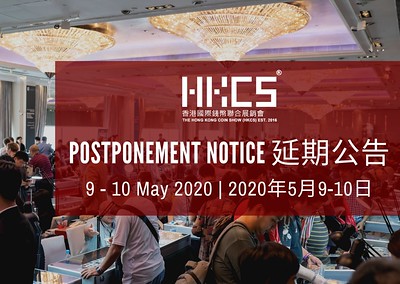
Since the Coronavirus first emerged in Wuhan China in December 2019, Stack's Bowers and Ponterio has been closely monitoring the situation and considering its effects on our clients, employees and global business. As a result of discussions with health experts, our staff and clients, we have made the decision to postpone our auction that was originally scheduled for March 23 to 25, 2020, until May 4 to 6, 2020. We believe this decision is in the best interest of protecting the safety and health of our staff and clients, as well as our bidders and consignors.
The rescheduled auction will still be held at the Mira Hotel and in conjunction with the Hong Kong Coin Show, which has been rescheduled for May 9-10.
Thank you for your support and understanding. Should you have any questions, please contact us. Hong Kong Office: infoHK@StacksBowers.com; +852 2117 1191. U.S. Office: info@StacksBowers.com: 800-458-4646.
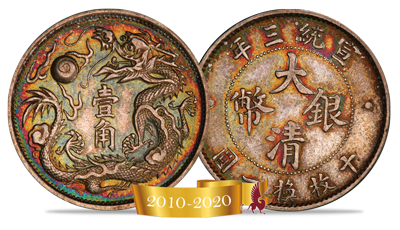
ANCIENT GEMS AND THEIR CONNECTION TO COINS
A lecture at the American Numismatic Society in New York next month will cover the topic of ancient engraved gems. -Editor
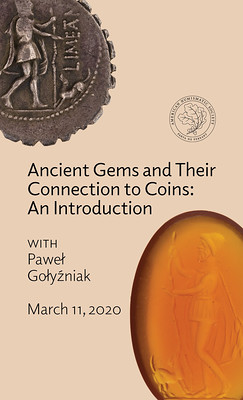 Join us for Ancient Gems and Their Connection to Coins: An
Introduction with Pawel Golyzniak on Wednesday, March 11.
Join us for Ancient Gems and Their Connection to Coins: An
Introduction with Pawel Golyzniak on Wednesday, March 11.
This lecture will give an overview of the study of ancient engraved gems and their relationship to coins. Various engraving techniques and materials will be discussed, placing these precious objects in their historical and political settings.
Pawel Golyzniak works as a Research Fellow in the Institute of Archaeology, Jagiellonian University in Krakow. His research interests include engraved gems (ancient and neo-classical), Roman Republican and Augustan numismatics, history of antiquarianism, collecting and scholarship as well as 18th century drawings of intaglios and cameos and the legacy of antiquary and connoisseur Philipp von Stosch (1691-1757).
RSVP to Emma Pratte at membership@numismatics.org
My own introduction to ancient gems came on my visit to Sir John Soane's museum in London in 2007. These engraved works are delightful. -Editor
To read the earlier E-Sylum article, see:
WAYNE'S LONDON DIARY 7 AUGUST, 2007: SIR JOHN SOANE'S MUSEUM (https://coinbooks.org/esylum_v10n32a17.html)
2020 BRITISH HISTORICAL MEDALLION CONGRESS
The British Historical Medallion Society organises a Congress every year in Warwick, UK. The society has announced the program for this year's event. -Editor
The annual British Historical Medallion Congress is to be held in Warwick on Saturday 13 June 2020.
The event, for collectors of commemorative and historical medallions, will be held at the Hilton Hotel, Warwick – this is conveniently located on the A429 within 200 yards of junction 15 on the M40.
- Philip Attwood, Keeper of the Department of Coins and Medals British Museum: “Three medal collectors”
- Andrew Wager: W.J. Taylor, medallist: an archival discovery
- Peter Clayton: “Remember Nelson”: Commemorative medals and medallions of Horatio Viscount Lord Nelson
- Neil Beaton: “Smeaton's Lighthouses: tokens or historical medals?”
- Alan Cope: “A tour around Nottinghamshire in medals Part 2
- John Cumbers: 'The Minchinhampton National Schools Prize Medal'
- Gary Oddie: “Admiral George Brydges Rodney”
- Frances Simmons: “Keepsakes, keep safe - medals as amulets”
- Mystery items and AGM of Historical Medallion Society: An opportunity for members to help to identify medals in each other's collections
After this there will be an evening meal followed by a Congress bourse giving the opportunity for delegates to acquire new specimens for their collection. A number of well- known specialist dealers have indicated they will be attending the bourse. The cost for 2020 will be £67 for the whole day, to include all refreshments, lunch, evening meal and parking – plus a copy of Issue 2 of the Historical Medal Journal.
Those wishing to stay overnight on the Saturday, in order to enjoy a leisurely Sunday in neighbouring Warwick or Stratford Upon Avon, can do so at the following rates: Overnight accommodation at the hotel is available to Congress delegates a £153 for a single room, to include Congress attendance plus Journal (as above), room and breakfast. For double rooms the cost will be £212. For delegates who may wish to stay on the preceding Friday night bed and breakfast at the hotel is available at £100 for a single room and £110 for a double.
It should be noted that on Sunday the Birmingham Coin Fair is held a short drive away at the National Motorcycle Museum and collectors could combine both events by staying overnight on the Saturday. A deposit of £25 per head will be required with the balance being due by Friday 15th May 2020.
For any further details and bookings (for both Congress and hotel accommodation) please contact John Cumbers email medallioncongress14@gmail.com

THE DUBAI COINS MUSEUM
Numismatourist Howard Berlin submitted this report in his recent visit to the Dubai Coins Museum. Thanks! -Editor
As Wayne mentioned in last week's E-Sylum, I was in Dubai and a funny thing happened to me on the way to the museum. I got left off in front of the Dubai Museum, commemorating the first fort in Dubai from the 18th century. When I inquired how to get to the Coins Museum in the Fahidi Fort area from there, one individual spoke up, dressed in the traditional white ghutra or keffiyeh headdress with black igal headband and the long thawb – an ankle-length tunic. He indicated that he would be glad to walk me to the museum. It was not just around the corner and my knees and lower back were starting to ache. This fellow then offered to bring his car around to drive me to the museum. I at first declined but only relented after he assured me that it was “no problem.” In about a few minutes, he arrived with his car and then proceeded to drive me to the museum. After I introduced myself and handed him my card and told him about my book about coin museums, he surprised me by telling me that he was the manager of the Dubai Museum! Talk about hospitality!
The Dubai Coins Museum is situated in a labyrinth maze of shops and a few other museums in the city's Al Fahidi Historical Neighborhood near the Ruler's Divan in Bur Dubai. It was opened in 2004. The museum has numismatic exhibits that belong to different historical eras. The museum is equipped with display cabinets and magnifying screens for each coin as well as computer touch screens with electronic drop-down lists containing detailed information on each coin, in regards to its shape, size, metal, method and date of minting, words written on it, and the images and shapes it contains.
The museum contains more than 470 specimens dating back to different historical eras. The museum includes eight main display rooms as follows:
1. Information about the history of coins.
2. 16 coins of Arab-Sasanian dirhams of the Rashidun and Umayyad Caliphates.
3. 64 dinars and dirhams of the Umayyad Caliphate.
4. 115 dinars and dirhams of the Abbasid Caliphate.
5. 45 coins minted in Egypt, the Levant and Turkey.
6. 91 coins minted in Iraq and the Islamic Orient region.
7. 22 coins minted in North Africa and Andalusia.
8. 102 coins minted in the Arabian Peninsula and the United Arab Emirates.
It also increases knowledge of the coins that had been used in Dubai and the region, in addition to getting acquainted with the close link between the monetary systems of the British Empire, India and the countries in the region before independence, and the formation of the federation. As one whose primary numismatic interest is of the coins and banknotes of the British Mandatory of Palestine, I was pleasantly surprised to see an enlarged replica of a 10-mil coin included.
Text material is given in both Arabic and English. The museum is open from 8:30 am to 3:30 pm, Sunday to Thursday (closed Friday and Saturday), and admission is free.
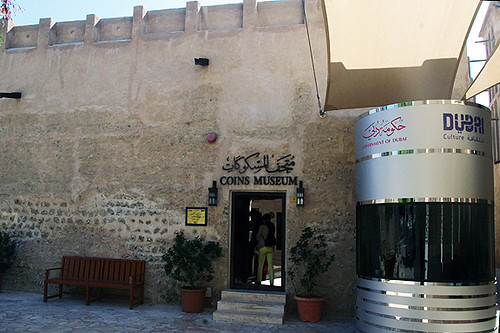
1. A view of the front entrance to the Dubai Coins Museum.
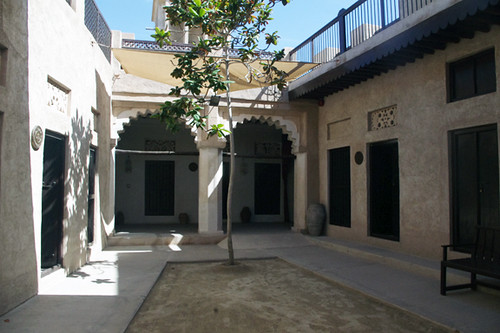
2. The museum's courtyard which has entrances to eight exhibits rooms that belong to different historical eras.
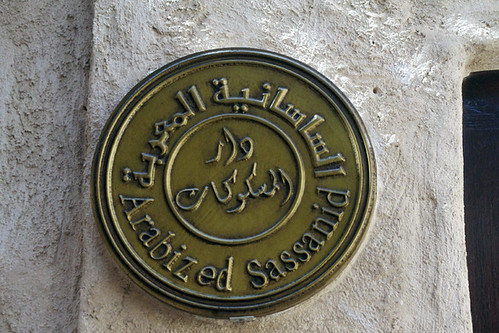
3. The theme of each exhibit is identified by a round emblem by the entrance door.
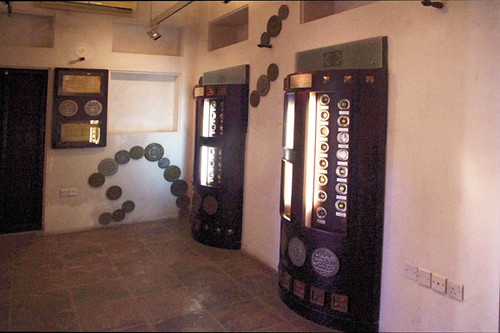
4. A view of one of the exhibit rooms showing displays of coins which can be individually rotated to see both the obverse and reverse sides.
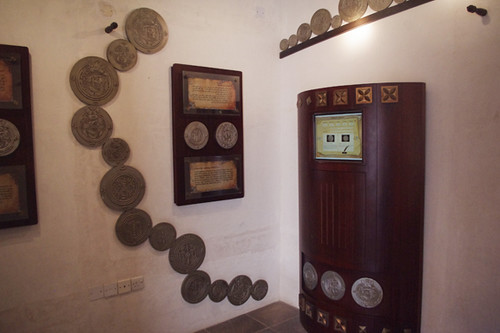
5. Another exhibit room showing a touch screen that can display detailed information about each coin. The enlarged coin replicas on the wall are actually carved from wood.
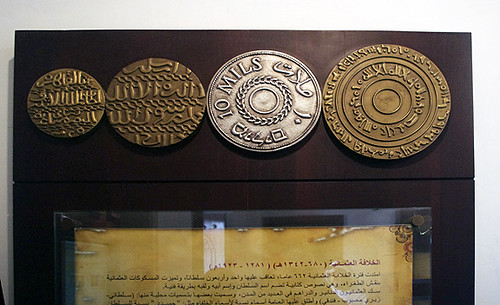
6. My favorite: an enlarged wooden replica of the reverse of the 10-mil coin of the British Mandate of Palestine
To read the earlier E-Sylum article, see:
NOTES FROM E-SYLUM READERS: FEBRUARY 16, 2020 : The Numismatourist in Dubai (https://www.coinbooks.org/v23/esylum_v23n07a14.html)
WAYNE'S NUMISMATIC DIARY: FEBRUARY 23, 2020
Tuesday, February 18, 2020 was the meeting night of my northern Virginia numismatic social group, Nummis Nova. Our host was Steve Bishop, and he'd chosen Delia's Mediterranean Grill & Brick Over Pizza in Alexandria. I was one of the last to arrive and slid onto a bench next to Julian Leidman and across from Tom Kays and Robert Hoppensteadt. Others already at the table included Jon Radel, Eric Schena, Dave Schenkman, and Mike Packard. Aaron Packard (no relation) arrived a little later and filled in the seat next to me.
We'd been there before. It's a small place, but I can't remember ever having a bad meal there. I ordered a glass of wine and shared some of the appetizers ordered by others, including pizza knots and hummus with pita bread. I ordered a roasted walnut salad and the chicken souvlaki.
Some numismatic goodies were already being passed around the table, and I added my contribution to the mix.
Mints and Minting
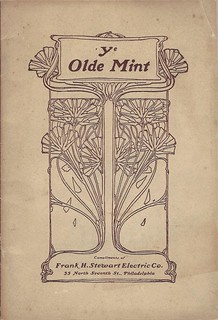 This month I acquired Dave Lange's duplicate How
to Make a Penny at the Philadelphia Mint pamphlet and added it to my numismatic ephemera collection. So I brought along to our meeting two binders of material relating to U.S. Mints and Minting. Here
are some selected images.
This month I acquired Dave Lange's duplicate How
to Make a Penny at the Philadelphia Mint pamphlet and added it to my numismatic ephemera collection. So I brought along to our meeting two binders of material relating to U.S. Mints and Minting. Here
are some selected images.
First up is the classic Frank Stewart publication Ye Olde Mint. Stewart owned two old Philadelphia Mint buildings and documented their history before replacing them with a new structure for his Frank H. Stewart Electric Company. He authored the 1924 book The History of the First United States Mint. For more information see the Asylum article by Joel Orosz and Len Augsburger, "Frank H. Stewart's Small Beginnings: Ye Olde Mint and Our New Home and Old Times."
To read the complete article on the Newman Portal, see:
https://nnp.wustl.edu/library/book/510157?page=7
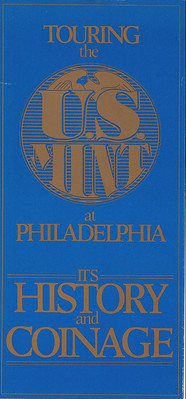
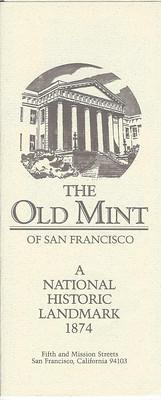
Here are two mint visitor pamphlets. On the left is "Touring the U.S. Mint at Philadelphia". It is undated but pictures 1964 coinage and is apparently from the late 1960s or early 1970s. On the right is "The Old Mint of San Francisco". It is also undated and appears to be from the 1980s.
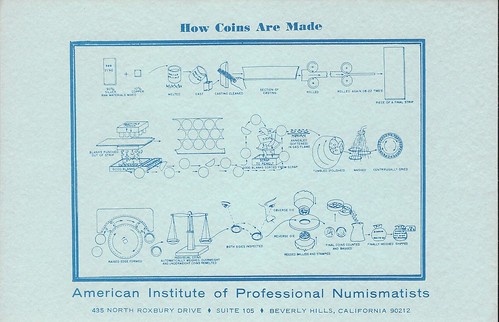
Here's a single sheet illustrating "How Coins Are Made" published by the American Institute of Professional Numismatists. The group also published a rare booklet by Walter Breen called The Minting Process, which I also have a copy of. The Beverly Hills address prompted Julian Liedman to ask if Abner Kreisberg was involved. Can anyone tell us more? Ads in Coin World in 1969 promoted a correspondence course in numismatics:
"Now YOU can have the rare opportunity to become a Professional Numismatist with a degree in Numismatics now exclusively available through the recently formed American Institute of Professional Numismatists. Here is your chance to become one of the true Professional Numismatists in this important hobby. No matter what your Numismatic interests or objectives are or how advanced you are a special TAILOR MADE educational course has been designed for you in mind. The course comes in 23 complete separate lessons and is in book length form complete with a final written examination at the end..."
The booklet is basically the entire course. My copy has a publication date of 1970 and lists Ronald J. Gillio as the publisher.
Bishop's Beauties
Steve Bishop's pieces were the first to come past my seat. The one that really jumped out at me was this amazing broadstruck Lincoln cent.
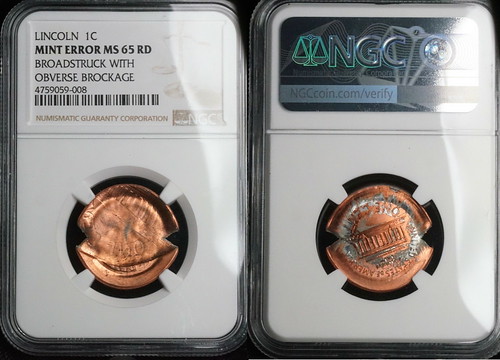
Along with several nice uncirculated Morgan dollars, Steve had these two overstruck Russian coppers.
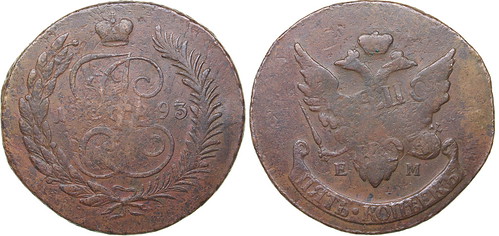
1793 EM 5 Kopecks Overstruck 15
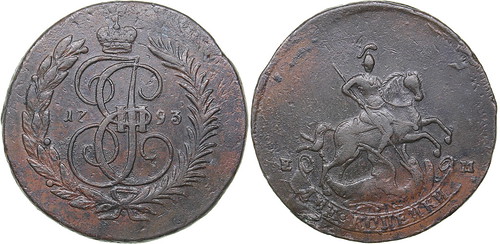
1793 EM 2 Kopecks Overstruck 3
Ivan Varbanov Fantasy Roman Provincial Coins
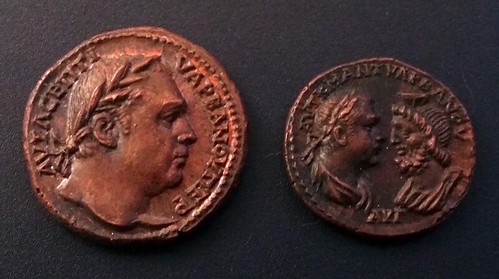
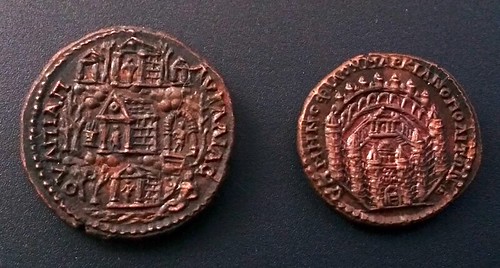
Robert Hoppensteadt brought along these two interesting fantasy Roman Provincial coins. He writes:
"I brought two small medallions that were engraved for Ivan Varbanov that copied a couple of famous Roman Provincial coins, only swapping out the emperor with his own likeness. He used to include them for friends who purchased his books. His latest book is THE COINAGE OF PHILIPPOPOLIS. The book is in two volumes of 202 and 420 pages, a full-color, hardcover edition. The data of 8500 coins was used to create the project. These "coins" have become collectible in their own right and even have listings in the Wildwinds database.
"Coin on right - Ivan Varbanov, AE27 (copper), based on an issue of Markianopolis, Moesia. AVT K M ANT VAΡBANOV AVΓ, laureate, draped bust of Ivan Varbanov right, facing draped bust of Serapis left, polos on head. / VΠ MHNOΦIΛOY MAΡKIANOΠOΛITΩN, legend ending in a small kantharos-like monogram, city view of Markianopolis, surrounded by wall with thirteen towers, temple and altar within the courtyard. Based on Moushmov 805; Varbanov 1972 of Gordian III.
"Coin on left - Ivan Varbanov, AE29 (copper), based on an issue of Pautalia, Thrace. AVT Λ CEΠTI VAΡBANOV ΠEΡ, laureate head of Ivan Varbanov right. / OYΛΠIAC ΠAYTAΛIAC (first AC ligate), View of the Pautalian mountain-temple complex, from top to bottom: central temple with deity standing left within and a tree and small shrine to left and right, another temple with deity standing within and an altar and tree to left and a cave entrance with a figure within and trees to right, another temple with a deity standing within and trees to left. River-god reclining left at the base of the mountain, holding cornucopiae. Based on Varbanov 4833 of Septimius Severus."
Robert added that Varbanov had to stop shipping his "coins" with the books after customs officials mistook them for real ancient coins.
Marine and River Phosphate Company Ad Note
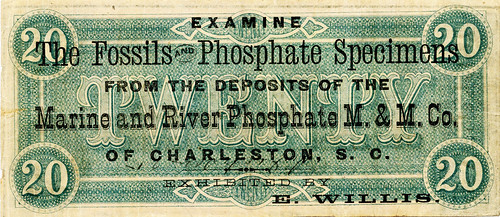
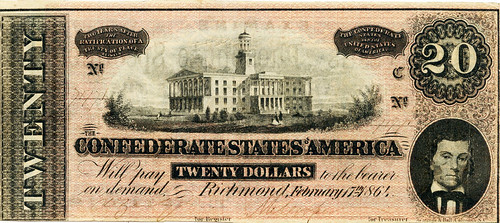
Dave Schenkman always has some interesting new exonumia rarities to share. Here's an advertising piece made by overprinting a $20 Confederate note. He writes:
"The Marine and River Phosphate Mining and Manufacturing Company operated from 1870 to about 1883."
Manufacturers Coal and Coke Company Cardboard Token
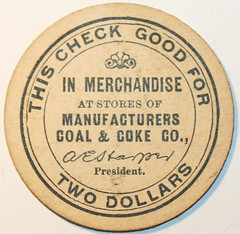
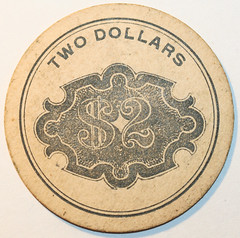
Dave next passed around this rare cardboard token. He writes:
"The Manufacturers Coal and Coke Company operated from about 1901 (or possibly a little earlier) to 1913, with mines in Iowa and Missouri, along the Iowa and St. Louis Railroad line. The company's office was in Connellsville, Missouri, a town the company established in 1902."
Tennessee Centennial Exposition
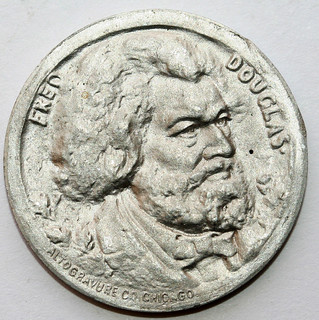
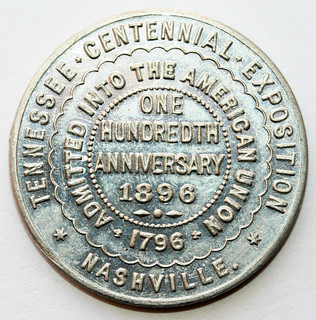
Dave also shared this 1896 medalet of the Tennessee Centennial Exposition featuring "Fred Douglas" made by the Autogravure Company of Chicago. I'd never heard of that manufacturer and a search of the web and the Newman Numismatic Portal came up empty. Can anyone tell us more?
South West Africa Chits
Eric Schena brought some great South West Africa items. The rest of this section contains his commentary and images. Thanks,
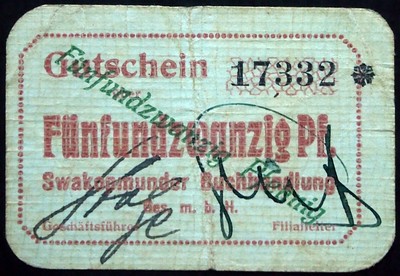
"I brought a pair of what I think are interesting related items from South West Africa (present-day Namibia). In 1915, German South West Africa was occupied by military forces under the Union of South Africa, who would continue to administer the country until 1991 (even though South Africa was supposed to relinquish control in 1922). Coinage was at a shortage before South African coins could be brought into South West Africa, so as a stopgap measure, a bookshop and printer located in the coastal city of Swakopmund was authorized to issue small chits ("gutschein" or voucher) in 1916 that were permitted to circulate throughout the country - the one I brought is good for 25 pfennig. The small chits of Swakopmunder Buchhandlung ("Swakopmund Bookshop") continued to be used until 1918 when they were withdrawn. The shop is still in business in its original location to this day in Namibia."
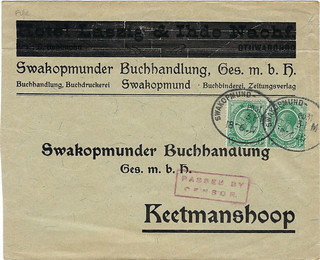
"I also brought a stamped advertising cover for Swakopmunder Buchhandlung dated June 18, 1917 (from the time frame the bookshop's chits were in use) mailed from Swakopmund to a satellite office in Keetmanshoop as an interesting "go-with" that gives a little bit of additional interest."
Some British Tokens
Aaron Packard brought along a number of tokens, including these British pieces. The rest of this section is comprised of his remarks and images. Thanks!
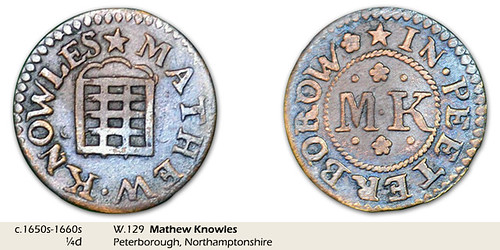
The first specimen is W.129 (W=Williamson) and is from Peterborough, Northamptonshire. It is a farthing, or ¼ a penny, or ¼d.
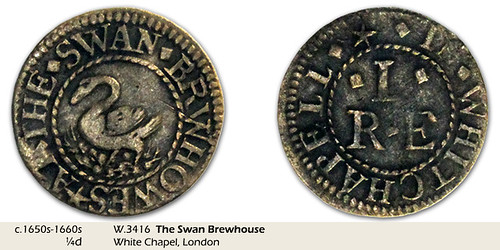
The second specimen is W.3416 and is from Whitechapel, London. It is also a farthing, or ¼ a penny, or ¼d.
The primary reason for this series of tokens was due to the chronic shortage of official coins small enough to fulfill the needs of everyday transactions. (Note that this was also recurring phenomenon in the U.S.) They appeared as early as 1648 with several spurts of farthing and halfpence emissions occurring as late as 1666-1667, and then use of them dwindled thereafter. By 1674 only a few places like Chester and Norwich had traders still commonly using them in commerce. To date, there are about 14,000 varieties of this series of emissions cataloged.
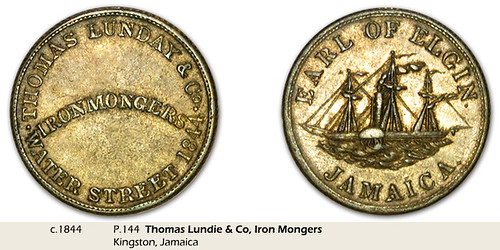
The third specimen is an advertising or fare card from Kingston Jamaica from the 19th century. It was issued by Thomas Lundie & Co. (Note the misspelling.) It measures 23mm in diameter with a diagonal milled edge. It is cataloged as P.144 or Pridmore No 144. The reverse features the paddle steamer ‘Earl of Elgin.' Lundie had brought the ship to the island for use in interisland and coastal trading. However, that venture did not ultimately work out, and by 1847 Lundie had sold it to the government of Haiti.
Tom's French Provincial Belle Epoche Medals
Tom Kays brought a great group of French medals, The rest of this section is comprised of his remarks and images. Thanks!
All Nummis Nova diners bring “show and share” items to see what gets a rise out of our fellow diners. I could have simply sent Wayne pictures of what I brought, without telling anything about them, but now I have time to tell the story to you, and to those who were seated far down the table from me who are probably still wondering what they saw. After many years of sharing, themes for exhibits have become somewhat eclectic. I brought a small collection of French provincial belle-epoche medals in a small mahogany display case, normally used for archeological artifacts, featuring unlikely but fascinating chapeaux. Digging into possible meanings behind the women's crazy hats I wonder if some French medalists intended to show perspective, while others are firmly planting strange items on the heads of their models. You decide which is which.
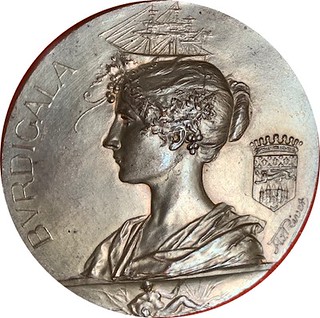
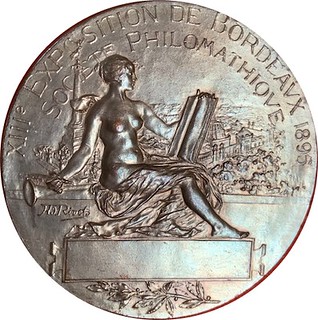
Bronze, Award Medal from the 13th Philomatic Society of Bordeaux Exposition of 1895 by Adolphe Rivet – (62 mm) – Obverse: Wreathed female bust with sailing ship above and Coat of Arms of Bordeaux, “BVRDIGALA” = Bordeaux in Latin. Reverse: Personification of Fame holding stylus and open notebook before a landscape of the exposition grounds in Bordeaux, and olive spray. “XIIIe EXPOSITION DE BORDEAVX 1895” / SOCIETE PHILOMATIQVE.
The Philomatic Society of Bordeaux was founded in 1808 and is an association of persons who love the sciences and industry. Of great interest at this expo was an exhibit of wine. From Engineering, Volume 60, The Bordeaux Exposition, of October 4, 1895 we find a complete visitors' description of the expo that ran from May to November. Here is an excerpt:
It is satisfactory to find many evidences that viticulture science is rapidly learning to set the efforts of the phylloxers (types of plant louse that ruin vines) at defiance, Besides the collections of French wines, are those of many other countries, of Spain and Portugal, the Rhine, Chili, Italy, California, and Russia (the Czar himself exhibiting wines made on his estates in the Caucasus). Displays of alcohols come from Belgium, Greece, Holland, the Argentina, and Japan.” Elsewhere were illustrations as far as possible of the varied applications of electricity, and a very large number of instruments. The Public Works Department of France makes a good display…of lighthouses, buoys, and other signals; there is also a very large model of the somewhat visionary scheme known as the “Canal des Deux Mars” a proposed navigable waterway between the Mediterranean and the Bay of Biscay…Collections of industrial arts such as bronzes, enamels, and jewelry, chemical, and pharmaceutical products, clothing, agricultural machinery, gas and domestic electricity used for lighting, heating, cooking, and transmission of signals, and heavy applications of elevators, motors, and sanitary railway carriages were spread out within the chambers, pavilions, halls, promenades, and among the monuments on the exhibition grounds.
Another example.
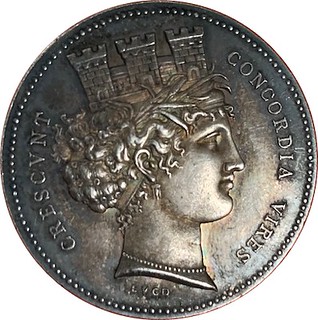
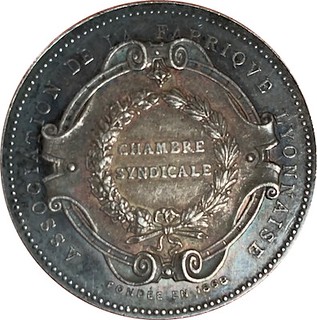
Silver, Award Medal of the Manufacturers Association of Lyon, France by Bonnet – (37 mm) - Obverse: Wreathed Head of Tyche (personification of the City of Lyon) wearing a turreted crown, pearl earrings and necklace, with legend “Crescvnt Concordia Vires,” and mint mark “LVGD” for Lugdunum = Lyon in Latin, with “Bonnet” at neck. Reverse: “Chambre Syndicale,” Association De La Fabriquve Lyonnaise,” and “Fondee en 1868.” Marked “Argent” on the edge.
What other examples of coins and medals showing unusual or distinctive headgear (wacky hats) might readers recommend join my collection? What new themes for show and share items should we assemble for future dinners? March is my month to set the stage for where we eat and what to bring.
 Historical Medal Journal
Historical Medal Journal
Jon Radel passed around his copy of the new Historical Medal Journal. It's very nicely done. See the article elsewhere in this issue for more information.
Wrapping Up
The group broke up about 9 o'clock. It was another great night of numismatic fellowship, and a fine meal to boot. I'm already looking forward to next month, which will fall on St.
Patrick's Day. How about an Irish theme?
COINAGE OF THE SIERRA LEONE COMPANY
Senior Numismatist and Cataloger Jeremy Bostwick published this article on the Stack's Bowers blog about the early coinage of the Sierra Leone Company. -Editor
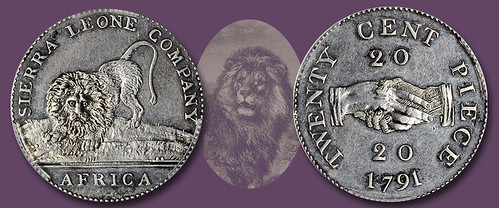
The Initial Numismatic Offerings of the Sierra Leone Company
Having its first contact with Europeans in the mid-15th century, the area that would become Sierra Leone saw use as a trading ground—for goods as well as slaves—for the next three centuries. By the late 18th century, however, the British Empire saw an opportunity to utilize this territory on the coast of western Africa as a colony for freed slaves (those who had escaped from American plantations and fought alongside the British during the Revolution) and for poor blacks in and around London. The initial foray as a settlement in 1787 suffered setbacks in the form of disease and conflict with nearby indigenous Africans. However, it was bolstered by additional settlers who emigrated from Nova Scotia in 1792, and was rebranded and re-established by the Sierra Leone Company. This company maintained its charter for the next 16 years; its end roughly coincided with the abolition of the slave trade within the British Empire in 1807. Following that, Sierra Leone existed as a British colony and served as a place to which freed slaves could settle. Independence from Britain finally came in 1961, with a Republic declared a decade later.
Numismatically, the Sierra Leone Company contributed some interesting additions to the collecting community. Matthew Boulton's Soho mint in Birmingham was commissioned to produce a series of denominations for the initial output of coinage in 1791. This series was uniform in design, with the obverse featuring an African lion somewhat crouching toward the viewer, seemingly ready to pounce. The reverse displays two hands clasped, one of which has shading to denote the cooperation of the settlement between black and white residents. It is notable that the penny was initially used (though it was quickly cast aside in favor of the decimal system), it being the first within the British Empire to do so. There are various denominations, owing to the vast experimentation of the Soho mint, as well as hotly collected varieties, off-metal strikings, and proof issues—many of which are very rare. One such example is featured our current Collectors Choice Online (CCO) sale—a 1791 20 Cent proof issue in silver. Though bearing the 1791 date, these pieces, just 84 in total, were issued by the Soho mint between 1793 and 1798 for customers looking to obtain examples of the type. Given the scant output, the present piece, graded PCGS PROOF-62 and very attractive and well preserved, is quite scarce and desirable.
To read the complete article, see:
The Initial Numismatic Offerings of the Sierra Leone Company
(https://www.stacksbowers.com/News/Pages/Blogs.aspx?ArticleID=sierra-leone-proof-2020)
1913 SANDBLAST PROOF DOUBLE EAGLE
Another Stack's Bowers blog article this week features a great U.S. proof coin. Senior Numismatist James McCartney wrote about the 1913 Sandblast Proof Double Eagle. Here's an excerpt. -Editor
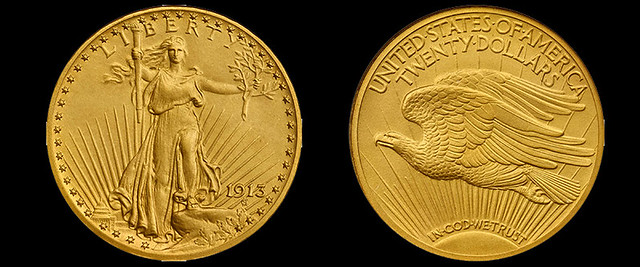
Records indicate that the Philadelphia Mint struck 99 Proof double eagles in 1913, though just 58 coins were distributed due to the declining interest in the Matte, Roman and Sandblast finishes used since 1907. The finish used to strike the 1913 issue is actually unique within the Proof Saint-Gaudens double eagle series, being a bit coarser than the Proof 1911 and Proof 1912, yet a bit finer than on the typical Proof 1914 and Proof 1915. We are delighted to feature a superior example of this 1913 Sandblast Proof double eagle in the Rarities Night session of our March 2020 Baltimore Auction. Certified Proof-66 by NGC, it ranks as the sole finest example to receive approval from CAC.
Survival estimates for the 1913 Proof double eagle have evolved significantly over the past several decades, as more examples have emerged from old collections and it has been studied in detail by scholars. In 1988, gold specialist David Akers remarked that "Proofs of 1913 are very rare; at most 20-25 are known." Q. David Bowers was more conservative when writing in 2004, suggesting that only 12 to 15 coins survived. The most recent research by John Dannreuther (2018) indicates that 35 to 45 distinct specimens remain, though most of these are in grades of Proof-65 and lower. At Proof-66 (NGC), this piece is significant, with only 14 coins certified finer by NGC.
To read the complete article, see:
Gem Sandblast Proof 1913 Double Eagle Featured in our March 2020 Baltimore Auction
(https://www.stacksbowers.com/News/Pages/Blogs.aspx?ArticleID=sandblast-proof-1913-saint-gaudens)
PERATROVICH DOLLAR MAY CIRCULATE IN ALASKA
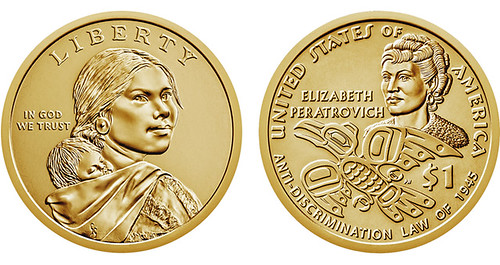
In the March 2020 issue of Alaskan Token Collector and Polar Numismatist Dick Hanscom writes:
"In the on-line version of Coin World today (Feb. 14), it was reported that the U.S. Mint was preparing to meet the State of Alaska's request for the release of 5 million Elizabeth Peratrovich Native American Dollars to circulation in Alaska. It will be the first dollar coin released to circulation since 2011.
Where the coins will be minted (Philadelphia, Denver or both), the logistics and the costs of getting them to banks in Alaska will be determined.
As has become standard practice the date, mint mark and “E Pluribus Unum” can be found on the edge. Determining the mint is not an easy task for those of us with old eyes.
And I just ordered 500 for $580 from the Mint on Feb. 12. Two days ago, I was hoping this would happen, but did not really believe that it would!"
I missed that - I fatfingered my Coin World email and missed last week's issue. Glad to hear the efforts of the club may bear fruit. -Editor
To read the earlier E-Sylum articles, see:
NATIVE AMERICAN COIN FIGURE PERATROVICH (https://www.coinbooks.org/v22/esylum_v22n42a16.html)
PERATROVICH DOLLAR RELEASE LOBBIED IN ALASKA (https://www.coinbooks.org/v22/esylum_v22n46a09.html)
PERATROVICH DOLLAR RELEASE BILL GAINS GROUND (https://www.coinbooks.org/v23/esylum_v23n05a21.html)
To read the Coin World article, see:
Mint prepares to meet Alaska's request for Native American dollars
(https://www.coinworld.com/news/us-coins/mint-prepares-to-meet-alaska-s-request-for-native-american-dollars)
AUSTRALIA'S QANTAS AIRLINE COMMEMORATIVE COINS
Australian collectors are queuing up to buy the new Qantas airline commemoratives. -Editor
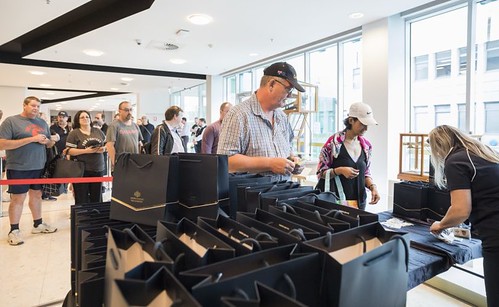
Australia's oldest airline Qantas has been featured on a $1 coin to celebrate its centenary, with people queuing up at the Royal Australian Mint on Monday to snap up the new addition.
The Mint hosted a pop-up stall where keen coin collectors were among the first to swap their cash for the freshly-minted circulating coins.
The Mint's general manager of sales, marketing and distribution, Mark Cartwright, said similar coin swaps were held in Brisbane, Melbourne and Sydney.
The coin will be legal tender and people should start seeing it straight away.
“Beyond Qantas being an iconic Australian organisation, we're really looking back at 100 years of aviation,” Mr Cartwright told Region Media.
“Qantas was one of the pioneers so we look at how society has changed and really benefitted a big country by opening up aviation and tourism and trade, firstly across Australia and then to the rest of the world.”
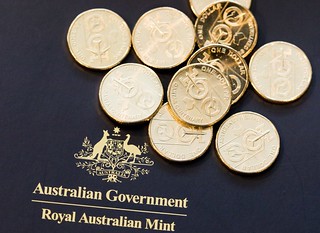 A team of designers at the Mint worked with Qantas to
design the coin that features a depiction of a plane flying through the number 100.
A team of designers at the Mint worked with Qantas to
design the coin that features a depiction of a plane flying through the number 100.
The plane is a stylised Boeing Dreamliner, the newest addition to the Qantas fleet. The decorative line pattern on the number 100 emulates fingerprints, signifying that Qantas is a part of Australia's national identity.
Mr Cartwright said the design is a reasonably simple one that will withstand the rigours of circulation, while there is a range of special coins that includes a set of coloured $1 coins that comes in a jet engine-shaped tin and tells the story of Qantas in Australia. There is also a gold plated 1 kg version that will be a very limited edition release.
To read the complete article, see:
New coin marks Australia's oldest airline
(https://the-riotact.com/new-coin-marks-australias-oldest-airline/358232)
THE ADAMS COMITIA AMERICANA MEDAL COLLECTION
On February 19, 2020 Greg Reynolds published an article on the Greysheet site about the recently auctioned “John W. Adams Collection of Comitia Americana and Related Medals. Here's an excerpt. -Editor
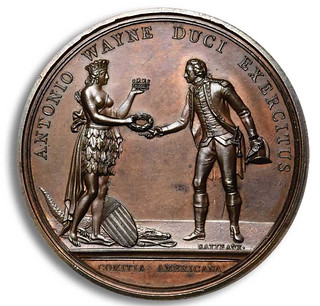
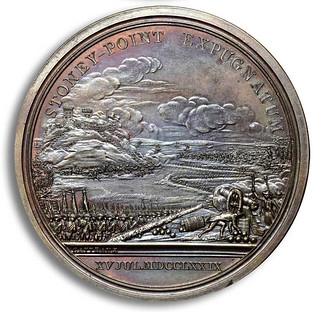
On Thursday, November 14, at the Baltimore Convention center, Stack's-Bowers auctioned the “John W. Adams Collection of Comitia Americana and Related Medals.” This auction session featured eighty-six Comitia Americana medals and die test pieces, plus fourteen other items related to the American Revolutionary War or to Benjamin Franklin as an individual. It may very well be that Adams had the most complete set of original Comitia Americana medals to have ever been auctioned.
Comitia Americana medals were awarded for heroism and strategic success in American Revolutionary War battles. The Continental Congress of the United States voted to award these medals while the war was in progress. The U.S. did not have an official mint until 1793. These medals were struck in Paris during the 1780s and early 1790s, except that American officials neglected to follow-up on the medal for Henry Lee for his performance at the Battle of Paulus Hook in August 1779.
Most of the collectors who seek Comitia Americana medals are content to acquire restrikes with original dies and novodels, which are medals struck later with copy dies at the Philadelphia Mint or in Paris. There are a large number of official restrikes and novodels, many of which were minted more than a half century after the corresponding originals were struck. Hundreds of collectors find restrikes and/or novodels to be desirable and affordable. The importance of the Adams Collection and this auction, however, stems from original Comitia American medals.
Several of Adams' medals were added to The Resolute Americana Collection, which probably now contains the most complete, privately owned set of Comitia Americana originals. This collection is focused upon early American numismatic items that are rare and historically important. The Resolute Americana Set of Comitia Americana medals will likely be on display at a museum in the west in 2026 in honor of the 250th anniversary of the Declaration of Independence.
Most of Adams' medals are among the finest known of their respective varieties. In several cases, he had the finest available to collectors.
To read the complete article, see:
SERIES ANALYSIS: The Greatest
Auction of American Revolutionary War Medals -- the Adams Collection of Comitia Americana
(https://www.greysheet.com/news/story?title=series-analysis-the-greatest-auction-of-american-revolutionary-war-medals-the-adams-collection-of-comitia-americana)
THE SELLING OF THE BAKER COLLECTION
Larry Dziubek and others pointed out this story by Stephan Salisbury published in The Philadelphia Inquirer and Pittsburgh Post-Gazette. Thanks. It covers the sale of the Baker collection of Washington medals by the Historical Society of Pennsylvania. Here's an excerpt - see the complete version online. -Editor
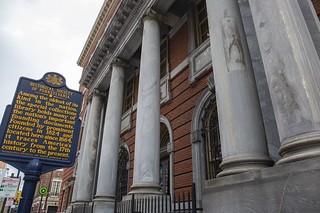 When William Spohn Baker, legendary collector
and authority on all things Washington, died in 1897, he gave his vast trove of books, prints, engravings, documents, coins, and commemorative George Washington medals to the Historical Society of
Pennsylvania, where he had served on the board for about 15 years.
When William Spohn Baker, legendary collector
and authority on all things Washington, died in 1897, he gave his vast trove of books, prints, engravings, documents, coins, and commemorative George Washington medals to the Historical Society of
Pennsylvania, where he had served on the board for about 15 years.
And the historical society was overjoyed to have it all.
But times change, and students will now have to seek enlightenment without some of those treasures.
On Nov. 16, 2019, with little notice to the general public, the 1,102 medals in the Baker Collection were sold in individual lots at a Baltimore auction, fetching about $2.2 million for the cash-strapped historical society. The medals all relate to Washington in some way, whether they were made during his time, ordered struck by him, depict him, or have another connection. The rest of the Baker Collection, including documentation of the medals, remains with the society.
Baker had explicitly stated in his will that the prints, medals, books, and other elements of the collection should be “kept together” and “marked and known as ‘The Baker Collection' with the distinct understanding that no print, medal or book shall on any pretense whatsoever be removed from the building” housing the historical society at 13th and Locust Streets.
The medals are now in private hands, scattered to the winds, and the collection is irrevocably broken.
According to public records, the sale came after Philadelphia Orphans' Court lifted Baker's supposedly permanent restrictions without even holding a hearing. The state Attorney General's Office, which is charged with looking after the public interest in matters related to charitable nonprofits, had no objections to the sale and advised HSP on how to write its petition to achieve the desired result — liquidation.
The sale comes at a time when the historical society is under such extreme financial stress that it laid off a third of its self-described “bare bones” staff last April. Then, this past summer, plans and hopes for an affiliation with Drexel University died, a Drexel spokesperson says now.
The court petition, filed in 2018, says that HSP is a library, not a museum, and is not equipped to care for three-dimensional objects.
To read the complete article, see:
Cash-strapped Historical Society of Pennsylvania is selling off
parts of its collection (https://www.inquirer.com/arts/historical-society-of-pennsylvania-george-washington-medals-auction-deaccession-20200215.html)
THE RISE AND FALL OF ARISTOPHIL
John Sallay forwarded this New York Times article from February 21, 2020 about the rise and fall of Aristophil, a French firm which bought and sold shares in rare books, autographs and manuscripts. -Editor
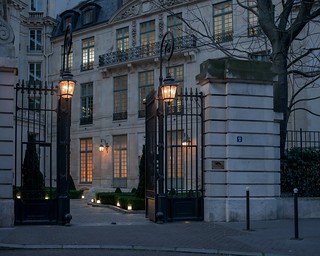 A letter from Frida Kahlo, signed and twice
kissed with red lipstick, fetched just over $8,800. A page of scribbled calculations by Isaac Newton sold for about $21,000. A 1953 handwritten speech by John F. Kennedy took in $10,000.
A letter from Frida Kahlo, signed and twice
kissed with red lipstick, fetched just over $8,800. A page of scribbled calculations by Isaac Newton sold for about $21,000. A 1953 handwritten speech by John F. Kennedy took in $10,000.
“Adjugé!” said a gray-haired auctioneer, over and over, as he gaveled away nearly every one of the 200 lots for sale at Drouot, an auction house, in Paris in mid-November. The sale generated $4.2 million, which might sound like a triumph.
Actually, the sale was a fiasco, or, more precisely, one part of an ongoing fiasco. All of the items came from a now-defunct company, Aristophil, which starting in 2002 built one of the largest collections of rare books, autographs and manuscripts in history — some 136,000 pieces in all.
The buying spree turned the company's founder and president, a stout 71-year-old named Gérard Lhéritier, into a celebrity. He opened the stately Museum of Letters and Manuscripts in a pricey neighborhood in Paris, and surrounded himself with French luminaries. They included former presidents, authors and journalists, who crowned him the “king of manuscripts.”
Today he's widely known by a less flattering name, “the Bernie Madoff of France.”
Six years ago, the French authorities shut down Aristophil and arrested Mr. Lhéritier, charging him with fraud and accusing him of orchestrating what amounts to a highbrow Ponzi scheme. As he bought all those rare manuscripts and letters, he had them appraised, divided their putative value into shares and sold them as if they were stock in a corporation. Those shares were bought by 18,000 people, many of them elderly and of modest means, who collectively invested about $1 billion.
The authorities seized the entire collection and hired a company to catalog and auction off all 136,000 pieces, a process that will take years and hundreds of sales, just like the one in November. The hope is to return as much money as possible to investors, which, based on the more than two dozen auctions already held, will amount to perhaps 10 cents on the dollar.
The problem has nothing to do with quality. Everything in the collection is authentic, and a large part of it is highly coveted. But the authorities say that with the help of pliant experts, Mr. Lhéritier grossly inflated the value of pieces before he sold shares in them. A set of Einstein documents he bought from Christie's in 2002 for $560,000, for instance, was divided into hundreds of shares and sold at a valuation of $13 million.
Seventeen years ago, Mr. Lhéritier crashed through the doors of the genteel market for manuscripts with all the subtlety of a famished wild boar. That Einstein collection was the first he divvied into virtual shares. Soon, representatives of Aristophil were rampaging through auctions around Europe and the United States, outbidding everyone for anything of quality.
By one estimate, Aristophil wound up with 5 percent of the global market for rare books and manuscripts.
The largess helped spread word of the extraordinary sums Aristophil was paying for rare books. And that caused Europeans to rummage through their libraries and sell off their treasures. Typically, rare manuscripts trickle into the market as they are inherited or discovered. Now, there was a flood. One expert estimates that a century's worth of items were coaxed out of private hands in 15 years.
Mr. Lhéritier benefited from a cycle: The publicity pried loose more documents, and the documents brought in more investors, which generated more publicity, which brought in more documents, and so on.
John adds:
I assume there are numismatic investment vehicles, which I also assume are legal and being run with fair intent, but the parallels between the antiquarian book market and the numismatic market – not to mention the numismatic book market – might provide some sort of cautionary tale.
Buyer beware. A number of numismatic investment funds have come and gone over the years. Many were quite honestly run, yet failed to deliver the gains investors hoped for. I hadn't heard of Aristophil, but I'm not into the autograph and manuscript world. Such a large player does create market distortions. Independent sellers who took the cash were winners in the game. No one who provided inflated fake estimates should get off scot free, but that can be hard to prove. -Editor
To read the complete article, see:
A Billion-Dollar Scandal Turns the ‘King of Manuscripts' Into the ‘Madoff of France'
(https://www.nytimes.com/2020/02/21/business/aristophil-lheritier-rare-books.html)
LOOSE CHANGE: FEBRUARY 23, 2020
Here are some additional items in the media this week that may be of interest. -Editor
Coronavirus Fears
Kavan Ratnatunga forwarded this article which asks the question, "Can touching Bank ATM Card, Credit Card, Currency Notes or Coins infect you?" -Editor
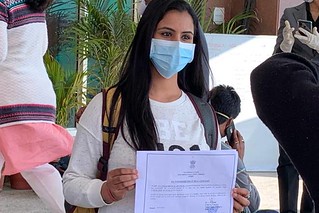 Is there a risk of being infected with the new
coronavirus by touching coins, bank currency notes, credit cards and other objects? The answer is yes but the possibility of such an infection is very low, according to the World Health Organisation
(WHO). “The risk of being infected with the new coronavirus by touching coins, banknotes, credit cards and other objects, is very low,” WHO says. The WHO has busted several myths about the new
coronavirus infection on its website.
Is there a risk of being infected with the new
coronavirus by touching coins, bank currency notes, credit cards and other objects? The answer is yes but the possibility of such an infection is very low, according to the World Health Organisation
(WHO). “The risk of being infected with the new coronavirus by touching coins, banknotes, credit cards and other objects, is very low,” WHO says. The WHO has busted several myths about the new
coronavirus infection on its website.
“With proper hand cleaning, the risk of being infected with the new coronavirus by touching objects, including coins, banknotes or indeed credit cards, is very low,” WHO suggests.
To read the complete article, see:
Coronavirus reason: Can touching Bank
ATM Card, Credit Card, Currency Notes or Coins infect you?
(https://www.financialexpress.com/lifestyle/health/coronavirus-reason-touching-credit-card-debit-card-currency-notes-or-coins-can-infect-you/1872798/)
Giant Gold Coin Thieves Sentenced to Prison
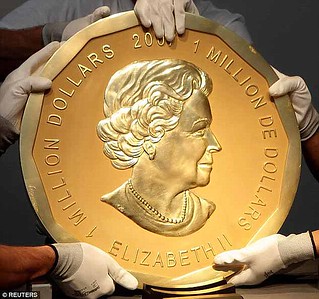 Three men who made away with one of the world's largest gold coins
from a Berlin Museum have been sentenced to prison.
Three men who made away with one of the world's largest gold coins
from a Berlin Museum have been sentenced to prison.
Cousins Ahmed and Wissam Remmo broke into Berlin's Bode Museum on the night of March 27, 2017, with the assistance of an inside man: Denis W., a childhood friend who had been hired as a security guard at the institution earlier that month. Using a skateboard and wheelbarrow, the crafty thieves absconded with “Big Maple Leaf,” a commemorative coin weighing in at a whopping 221 pounds that had been issued by the Royal Canadian Mint in 2007.
To read the complete article, see:
The Bumbling Thieves Who Stole an Enormous $4.3 Million Gold Coin From a Berlin Museum—and Probably Melted It Down—Are Heading to
Prison (https://news.artnet.com/art-world/berlin-coin-theft-1783515)
Collecting Banana Labels
Here's a great CNN article in the other-things-people-collect department: banana labels. Read the article, and you'll find many parallels in interest, sensibilities and determination with those of us in the numismatic world. -Editor
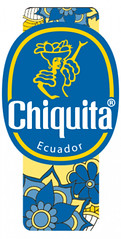 "I wondered how many different countries I could find on those Dole labels," Martz said. "That is when I first started
paying attention to them and noticing differences. I like that they are free. I like that they are designed to capture your attention. I like that they send messages. I like that they are tiny works
of art."
"I wondered how many different countries I could find on those Dole labels," Martz said. "That is when I first started
paying attention to them and noticing differences. I like that they are free. I like that they are designed to capture your attention. I like that they send messages. I like that they are tiny works
of art."
To read the complete article, see:
How one Florida woman amassed a collection of more than 21,000 banana labels
(https://www.cnn.com/2020/02/22/us/banana-label-collector-becky-martz-trnd/index.html)

